Main Body
3 Chapter 3 – Argument
Kirsten DeVries
At school, at work, and in everyday life, argument is one of main ways we exchange ideas with one another. Academics, business people, scientists, and other professionals all make arguments to determine what to do or think, or to solve a problem by enlisting others to do or believe something they otherwise would not. Not surprisingly, then, argument dominates writing, and training in argument writing is essential for all college students.
This chapter will explore how to define argument, how to talk about argument, how logic works in argument, the main argument types, and a list of logical fallacies.
2. What Are the Components and Vocabulary of Argument?
4. What Are the Different Types of Argument in Writing?
5. A Repository of Logical Fallacies
1. What Is Argument?
All people, including you, make arguments on a regular basis. When you make a claim and then support the claim with reasons, you are making an argument. Consider the following:
- If, as a teenager, you ever made a case for borrowing your parents’ car using reasonable support—a track record of responsibility in other areas of your life, a good rating from your driving instructor, and promises to follow rules of driving conduct laid out by your parents—you have made an argument.
- If, as an employee, you ever persuaded your boss to give you a raise using concrete evidence—records of sales increases in your sector, a work calendar with no missed days, and personal testimonials from satisfied customers—you have made an argument.
- If, as a gardener, you ever shared your crops at a farmer’s market, declaring that your produce is better than others using relevant support—because you used the most appropriate soil, water level, and growing time for each crop—you’ve made an argument.
- If, as a literature student, you ever wrote an essay on your interpretation of a poem—defending your ideas with examples from the text and logical explanations for how those examples demonstrate your interpretation—you have made an argument.
The two main models of argument desired in college courses as part of the training for academic or professional life are rhetorical argument and academic argument. If rhetoric is the study of the craft of writing and speaking, particularly writing or speaking designed to convince and persuade, the student studying rhetorical argument focuses on how to create an argument that convinces and persuades effectively. To that end, the student must understand how to think broadly about argument, the particular vocabulary of argument, and the logic of argument. The close sibling of rhetorical argument is academic argument, argument used to discuss and evaluate ideas, usually within a professional field of study, and to convince others of those ideas. In academic argument, interpretation and research play the central roles.
However, it would be incorrect to say that academic argument and rhetorical argument do not overlap. Indeed, they do, and often. A psychologist not only wishes to prove an important idea with research, but she will also wish to do so in the most effective way possible. A politician will want to make the most persuasive case for his side, but he should also be mindful of data that may support his points. Thus, throughout this chapter, when you see the term argument, it refers to a broad category including both rhetorical and academic argument.
Before moving to the specific parts and vocabulary of argument, it will be helpful to consider some further ideas about what argument is and what it is not.
Argument vs. Controversy or Fight
Consumers of written texts are often tempted to divide writing into two categories: argumentative and non-argumentative. According to this view, to be argumentative, writing must have the following qualities: It has to defend a position in a debate between two or more opposing sides, it must be on a controversial topic, and the goal of such writing must be to prove the correctness of one point of view over another.
A related definition of argument implies a confrontation, a clash of opinions and personalities, or just a plain verbal fight. It implies a winner and a loser, a right side and a wrong one. Because of this understanding of the word “argument,” many students think the only type of argument writing is the debate-like position paper, in which the author defends his or her point of view against other, usually opposing, points of view.(
These two characteristics of argument—as controversial and as a fight—limit the definition because arguments come in different disguises, from hidden to subtle to commanding. It is useful to look at the term “argument” in a new way. What if we think of argument as an opportunity for conversation, for sharing with others our point of view on an issue, for showing others our perspective of the world? What if we think of argument as an opportunity to connect with the points of view of others rather than defeating those points of view?
One community that values argument as a type of communication and exchange is the community of scholars. They advance their arguments to share research and new ways of thinking about topics. Biologists, for example, do not gather data and write up analyses of the results because they wish to fight with other biologists, even if they disagree with the ideas of other biologists. They wish to share their discoveries and get feedback on their ideas. When historians put forth an argument, they do so often while building on the arguments of other historians who came before them. Literature scholars publish their interpretations of different works of literature to enhance understanding and share new views, not necessarily to have one interpretation replace all others. There may be debates within any field of study, but those debates can be healthy and constructive if they mean even more scholars come together to explore the ideas involved in those debates. Thus, be prepared for your college professors to have a much broader view of argument than a mere fight over a controversial topic or two.
Argument vs. Opinion
Argument is often confused with opinion. Indeed, arguments and opinions sound alike. Someone with an opinion asserts a claim that he thinks is true. Someone with an argument asserts a claim that she thinks is true. Although arguments and opinions do sound the same, there are two important differences:
- Arguments have rules; opinions do not. In other words, to form an argument, you must consider whether the argument is reasonable. Is it worth making? Is it valid? Is it sound? Do all of its parts fit together logically? Opinions, on the other hand, have no rules, and anyone asserting an opinion need not think it through for it to count as one; however, it will not count as an argument.
- Arguments have support; opinions do not. If you make a claim and then stop, as if the claim itself were enough to demonstrate its truthfulness, you have asserted an opinion only. An argument must be supported, and the support of an argument has its own rules. The support must also be reasonable, relevant, and sufficient.
Figure 3.1 “Opinion vs Argument”
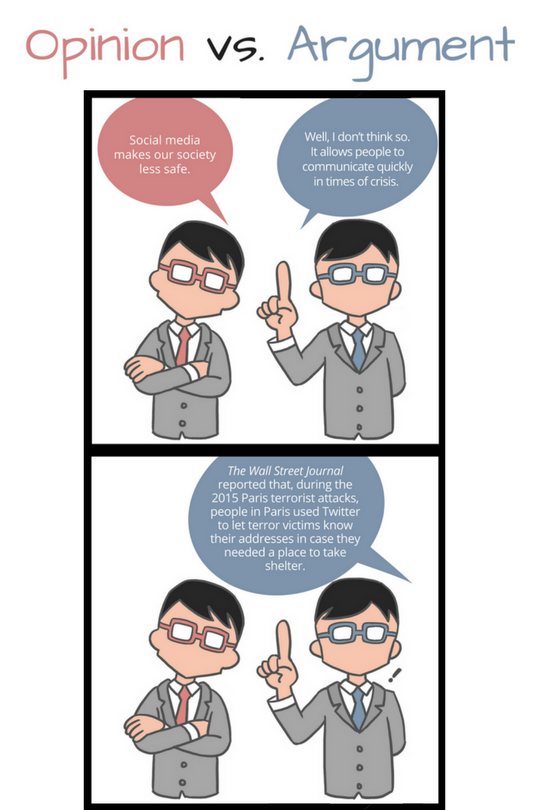
Argument vs. Thesis
Another point of confusion is the difference between an argument and an essay’s thesis. For college essays, there is no essential difference between an argument and a thesis; most professors use these terms interchangeably. An argument is a claim that you must then support. The main claim of an essay is the point of the essay and provides the purpose for the essay. Thus, the main claim of an essay is also the thesis. For more on the thesis, see Chapter 4, “The Writing Process.”
Consider this as well: Most formal essays center upon one main claim (the thesis) but then support that main claim with supporting evidence and arguments. The topic sentence of a body paragraph can be another type of argument, though a supporting one, and, hence, a narrower one. Try not to be confused when professors call both the thesis and topic sentences arguments. They are not wrong because arguments come in different forms; some claims are broad enough to be broken down into a number of supporting arguments. Many longer essays are structured by the smaller arguments that are a part of and support the main argument. Sometimes professors, when they say supporting points or supporting arguments, mean the reasons (premises) for the main claim (conclusion) you make in an essay. If a claim has a number of reasons, those reasons will form the support structure for the essay, and each reason will be the basis for the topic sentence of its body paragraph.
Argument vs. Fact
Arguments are also commonly mistaken for statements of fact. This comes about because often people privilege facts over opinions, even as they defend the right to have opinions. In other words, facts are “good,” and opinions are “bad,” or if not exactly bad, then fuzzy and thus easy to reject. However, remember the important distinction between an argument and an opinion stated above: While argument may sound like an opinion, the two are not the same. An opinion is an assertion, but it is left to stand alone with little to no reasoning or support. An argument is much stronger because it includes and demonstrates reasons and support for its claim.
As for mistaking a fact for an argument, keep this important distinction in mind: An argument must be arguable. In everyday life, arguable is often a synonym for doubtful. For an argument, though, arguable means that it is worth arguing, that it has a range of possible answers, angles, or perspectives: It is an answer, angle, or perspective with which a reasonable person might disagree. Facts, by virtue of being facts, are not arguable. Facts are statements that can be definitely proven using objective data. The statement that is a fact is absolutely valid. In other words, the statement can be pronounced as definitively true or definitively false. For example, 2 + 2 = 4. This expression identifies a verifiably true statement, or a fact, because it can be proved with objective data. When a fact is established, there is no other side, and there should be no disagreement.
The misunderstanding about facts (being inherently good) and argument (being inherently problematic because it is not a fact) leads to the mistaken belief that facts have no place in an argument. This could not be farther from the truth. First of all, most arguments are formed by analyzing facts. Second, facts provide one type of support for an argument. Thus, do not think of facts and arguments as enemies; rather, they work closely together.
Explicit vs. Implicit Arguments
Arguments can be both explicit and implicit. Explicit arguments contain prominent and definable thesis statements and multiple specific proofs to support them. This is common in academic writing from scholars of all fields. Implicit arguments, on the other hand, work by weaving together facts and narratives, logic and emotion, personal experiences and statistics. Unlike explicit arguments, implicit ones do not have a one-sentence thesis statement. Implicit arguments involve evidence of many different kinds to build and convey their point of view to their audience. Both types use rhetoric, logic, and support to create effective arguments.
Exercise 1
Go on a hunt for an implicit argument in the essay, “37 Who Saw Murder Didn’t Call the Police” (https://tinyurl.com/yc35o25x) by Martin Gansberg.
1. Read the article, and take notes on it–either using a notebook or by annotating a printed copy of the text itself (for help with note-taking on reading material, see Chapter 1, “Critical Reading.” Mark or write down all the important details you find.
2. After you are finished reading, look over your notes or annotations. What do all the details add up to? Use the details you have read about to figure out what Gansberg’s implicit argument is in his essay. Write it in your own words.
Argument and Rhetoric
An argument in written form involves making choices, and knowing the principles of rhetoric allows a writer to make informed choices about various aspects of the writing process. Every act of writing takes place in a specific rhetorical situation. The most basic and important components of a rhetorical situation are
- Author of the text.
- Purpose of the text.
- Intended audience (i.e., those the author imagines will be reading the text).
- Form or type of text.
These components give readers a way to analyze a text on first encounter. These factors also help writers select their topics, arrange their material, and make other important decisions about the argument they will make and the support they will need. For more on rhetoric, see Chapter 2, “Rhetorical Analysis.”
Key Takeaways: What is an Argument?
With this brief introduction, you can see what rhetorical or academic argument is not:
- An argument need not be controversial or about a controversy.
- An argument is not a mere fight.
- An argument does not have a single winner or loser.
- An argument is not a mere opinion.
- An argument is not a statement of fact.
Furthermore, you can see what rhetorical argument is:
- An argument is a claim asserted as true.
- An argument is arguable.
- An argument must be reasonable.
- An argument must be supported.
- An argument in a formal essay is called a thesis. Supporting arguments can be called topic sentences.
- An argument can be explicit or implicit.
- An argument must be adapted to its rhetorical situation.
2. What Are the Components and Vocabulary of Argument?
Questions are at the core of arguments. What matters is not just that you believe that what you have to say is true, but that you give others viable reasons to believe it as well—and also show them that you have considered the issue from multiple angles. To do that, build your argument out of the answers to the five questions a rational reader will expect answers to. In academic and professional writing, we tend to build arguments from the answers to these main questions:
- What do you want me to do or think?
- Why should I do or think that?
- How do I know that what you say is true?
- Why should I accept the reasons that support your claim?
- What about this other idea, fact, or consideration?
- How should you present your argument?
When you ask people to do or think something they otherwise would not, they quite naturally want to know why they should do so. In fact, people tend to ask the same questions. As you make a reasonable argument, you anticipate and respond to readers’ questions with a particular part of argument:
1. The answer to What do you want me to do or think? is your conclusion: “I conclude that you should do or think X.”
2. The answer to Why should I do or think that? states your premise: “You should do or think X because . . .”
3. The answer to How do I know that what you say is true? presents your support: “You can believe my reasons because they are supported by these facts . . .”
4. The answer to Why should I accept that your reasons support your claim? states your general principle of reasoning, called a warrant: “My specific reason supports my specific claim because whenever this general condition is true, we can generally draw a conclusion like mine.”
5. The answer to What about this other idea, fact, or conclusion?acknowledges that your readers might see things differently and then responds to their counterarguments.
6. The answer to How should you present your argument? leads to the point of view, organization, and tone that you should use when making your arguments.
As you have noticed, the answers to these questions involve knowing the particular vocabulary about argument because these terms refer to specific parts of an argument. The remainder of this section will cover the terms referred to in the questions listed above as well as others that will help you better understand the building blocks of argument.
What Is a Conclusion, and What Is a Premise?
The root notion of an argument is that it convinces us that something is true. What we are being convinced of is the conclusion. An example would be this claim:
Littering is harmful.
A reason for this conclusion is called the premise. Typically, a conclusion will be supported by two or more premises. Both premises and conclusions are statements. Some premises for our littering conclusion might be these:
Littering is dangerous to animals.
Littering is dangerous to humans.
Thus, to be clear, understand that an argument asserts that the writer’s claim is true in two main parts: the premises of the argument exist to show that the conclusion is true.
Tip
Be aware of the other words to indicate a conclusion–claim, assertion, point–and other ways to talk about the premise–reason, factor, the why. Also, do not confuse this use of the word conclusion with a conclusion paragraph for an essay.
What Is a Statement?
A statement is a type of sentence that can be true or false and corresponds to the grammatical category of a declarative sentence. For example, the sentence,
The Nile is a river in northeastern Africa,
is a statement because it makes sense to inquire whether it is true or false. (In this case, it happens to be true.) However, a sentence is still a statement, even if it is false. For example, the sentence,
The Yangtze is a river in Japan,
is still a statement; it is just a false statement (the Yangtze River is in China). In contrast, none of the following sentences are statements:
Please help yourself to more casserole.
Don’t tell your mother about the surprise.
Do you like Vietnamese pho?
None of these sentences are statements because it does not make sense to ask whether those sentences are true or false; rather, they are a request, a command, and a question, respectively. Make sure to remember the difference between sentences that are declarative statements and sentences that are not because arguments depend on declarative statements.
Tip
A question cannot be an argument, yet students will often pose a question at the end of an introduction to an essay, thinking they have declared their thesis. They have not. If, however, they answer that question (conclusion) and give some reasons for that answer (premises), they then have the components necessary for both an argument and a declarative statement of that argument (thesis).
To reiterate: All arguments are composed of premises and conclusions, both of which are types of statements. The premises of the argument provide reasons for thinking that the conclusion is true. Arguments typically involve more than one premise.
What Is Standard Argument Form?
A standard way of capturing the structure of an argument, or diagramming it, is by numbering the premises and conclusion. For example, the following represents another way to arrange the littering argument:
- Littering is harmful
- Litter is dangerous to animals
- Litter is dangerous to humans
This numbered list represents an argument that has been put into standard argument form. A more precise definition of an argument now emerges, employing the vocabulary that is specific to academic and rhetorical arguments. An argument is a set of statements, some of which (the premises: statements 2 and 3 above) attempt to provide a reason for thinking that some other statement (the conclusion: statement 1) is true.
Tip
Diagramming an argument can be helpful when trying to figure out your essay’s thesis. Because a thesis is an argument, putting the parts of an argument into standard form can help sort ideas. You can transform the numbered ideas into a cohesive sentence or two for your thesis once you are more certain what your argument parts are.
Figure 3.2 “Argument Diagram”
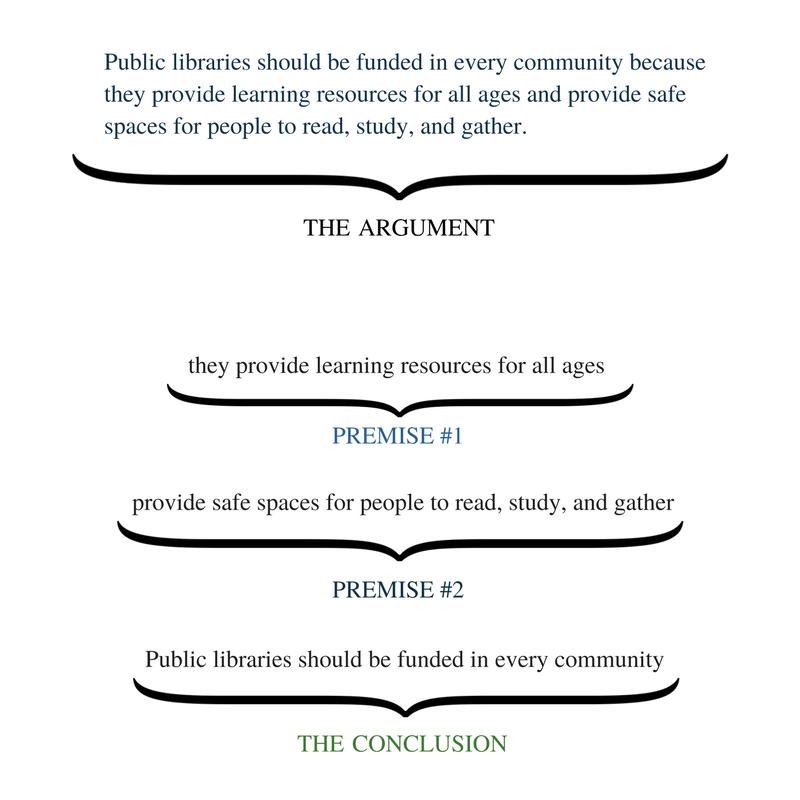
Recognizing arguments is essential to analysis and critical thinking; if you cannot distinguish between the details (the support) of a piece of writing and what those details are there to support (the argument), you will likely misunderstand what you are reading. Additionally, studying how others make arguments can help you learn how to effectively create your own.
What Are Argument Indicators?
While mapping an argument in standard argument form can be a good way to figure out and formulate a thesis, identifying arguments by other writers is also important. The best way to identify an argument is to ask whether a claim exists (in statement form) that a writer justifies by reasons (also in statement form). Other identifying markers of arguments are key words or phrases that are premise indicators or conclusion indicators. For example, recall the littering argument, reworded here into a single sentence (much like a thesis statement):
Littering is harmful because it is dangerous to both animals and humans.
The word “because” here is a premise indicator. That is, “because” indicates that what follows is a reason for thinking that littering is bad. Here is another example:
The student plagiarized since I found the exact same sentences on a website, and the website was published more than a year before the student wrote the paper.
In this example, the word “since” is a premise indicator because what follows is a statement that is clearly intended to be a reason for thinking that the student plagiarized (i.e., a premise). Notice that in these two cases, the premise indicators “because” and “since” are interchangeable: “because” could be used in place of “since” or “since” in the place of “because,” and the meaning of the sentences would have been the same.
Figure 3.3 “Common Premise Indicators”
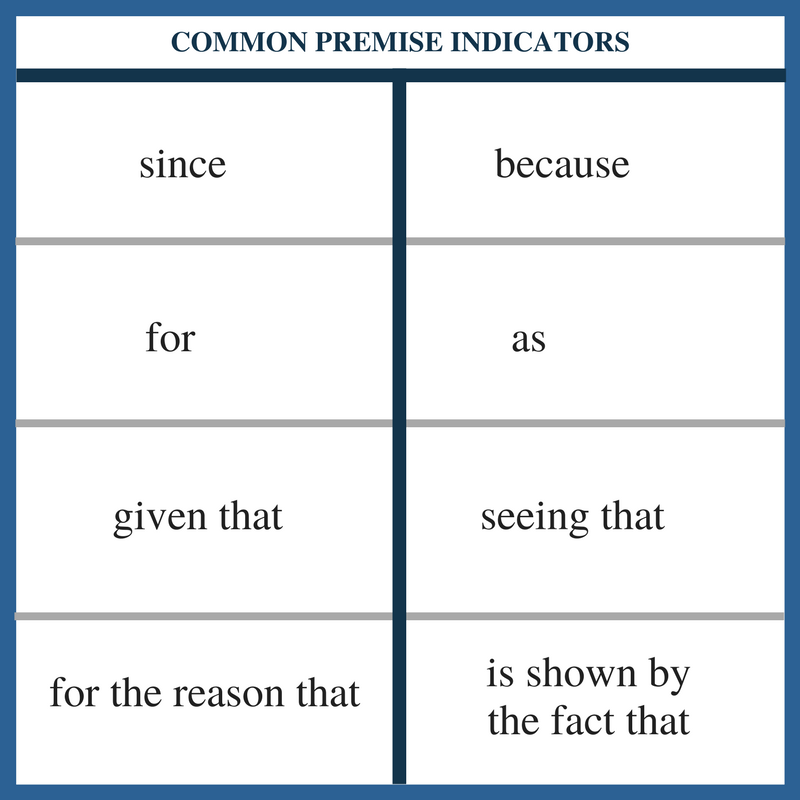
In addition to premise indicators, there are also conclusion indicators. Conclusion indicators mark that what follows is the conclusion of an argument. For example,
Bob-the-arsonist has been dead for a year, so Bob-the-arsonist didn’t set the fire at the East Lansing Starbucks last week.
In this example, the word “so” is a conclusion indicator because what follows it is a statement that someone is trying to establish as true (i.e., a conclusion). Here is another example of a conclusion indicator:
A poll administered by Gallup (a respected polling company) showed candidate X to be substantially behind candidate Y with only a week left before the vote; therefore, candidate Y will probably not win the election.
In this example, the word “therefore” is a conclusion indicator because what follows it is a statement that someone is trying to establish as true (i.e., a conclusion). As before, in both of these cases, the conclusion indicators “so” and “therefore” are interchangeable: “So” could be used in place of “therefore” or “therefore” in the place of “so,” and the meaning of the sentences would have been the same.
Figure 3.4 “Common Conclusion Indicators”
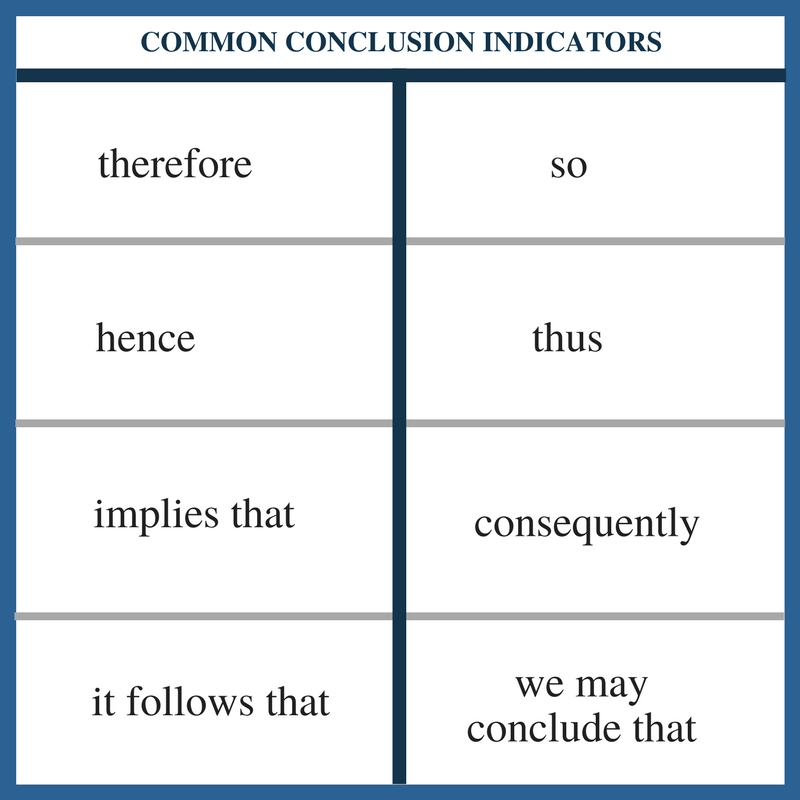
Exercise 2 (OPTIONAL)
Which of the following are arguments? If it is an argument, identify the conclusion (claim) of the argument. If it is not an argument, explain why not. Remember to look for the qualifying features of an argument: (1) It is a statement or series of statements, (2) it states a claim (a conclusion), and (3) it has at least one premise (reason for the claim).
- The woman with the hat is not a witch since witches have long noses, and she doesn’t have a long nose.
- I have been wrangling cattle since before you were old enough to tie your own shoes.
- Albert is angry with me, so he probably won’t be willing to help me wash the dishes.
- First, I washed the dishes, and then I dried them.
- If the road weren’t icy, the car wouldn’t have slid off the turn.
- Marvin isn’t a fireman and isn’t a fisherman, either.
- Are you seeing the rhinoceros over there? It’s huge!
- Obesity has become a problem in the US because obesity rates have risen over the past four decades.
- Bob showed me a graph with rising obesity rates, and I was very surprised to see how much they had risen.
- Marvin isn’t a fireman because Marvin is a Greyhound, which is a type of dog, and dogs can’t be firemen.
- What Susie told you is not the actual reason she missed her flight to Denver.
- Carol likely forgot to lock her door this morning because she was distracted by a clown riding a unicycle while singing Lynyrd Skynyrd’s “Simple Man.”
- No one who has ever gotten frostbite while climbing K2 has survived to tell about it; therefore, no one ever will.
What Constitutes Support?
To ensure that your argument is sound—that the premises for your conclusion are true—you must establish support. The burden of proof, to borrow language from law, is on the one making an argument, not on the recipient of an argument. If you wish to assert a claim, you must then also support it, and this support must be relevant, logical, and sufficient.
It is important to use the right kind of evidence, to use it effectively, and to have an appropriate amount of it.
- If, for example, your philosophy professor did not like that you used a survey of public opinion as your primary evidence in an ethics paper, you most likely used material that was not relevant to your topic. Rather, you should find out what philosophers count as good evidence. Different fields of study involve types of evidence based on relevance to those fields.
- If your professor has put question marks by your thesis or has written, “It does not follow,” you likely have problems with logic. Make sure it is clear how the parts of your argument logically fit together.
- If your instructor has told you that you need more analysis, suggested that you are “just listing” points or giving a “laundry list,” you likely have not included enough explanation for how a point connects to and supports your argument, which is another problem with logic, this time related to the warrants of your argument. You need to fully incorporate evidence into your argument. (See more on warrants immediately below.)
- If you see comments like “for example?,” “proof?,” “go deeper,” or “expand,” you may need more evidence. In other words, the evidence you have is not yet sufficient. One or two pieces of evidence will not be enough to prove your argument. Similarly, multiple pieces of evidence that aren’t developed thoroughly would also be flawed, also insufficient. Would a lawyer go to trial with only one piece of evidence? No, the lawyer would want to have as much evidence as possible from a variety of sources to make a viable case. Similarly, a lawyer would fully develop evidence for a claim using explanation, facts, statistics, stories, experiences, research, details, and the like.
You will find more information about the different types of evidence, how to find them, and what makes them credible in Chapter 6, “Research.” Logic will be covered later on in this chapter.
What Is the Warrant?
Above all, connect the evidence to the argument. This connection is the warrant. Evidence is not self-evident. In other words, after introducing evidence into your writing, you must demonstrate why and how this evidence supports your argument. You must explain the significance of the evidence and its function in your paper. What turns a fact or piece of information into evidence is the connection it has with a larger claim or argument: Evidence is always evidence for or against something, and you have to make that link clear.
Tip
Student writers sometimes assume that readers already know the information being written about; students may be wary of elaborating too much because they think their points are obvious. But remember, readers are not mind readers: Although they may be familiar with many of the ideas discussed, they don’t know what writers want to do with those ideas unless they indicate that through explanations, organization, and transitions. Thus, when you write, be sure to explain the connections you made in your mind when you chose your evidence, decided where to place it in your paper, and drew conclusions based on it.
What Is a Counterargument?
Remember that arguments are multi-sided. As you brainstorm and prepare to present your idea and your support for it, consider other sides of the issue. These other sides are counterarguments. Make a list of counterarguments as you work through the writing process, and use them to build your case – to widen your idea to include a valid counterargument, to explain how a counterargument might be defeated, to illustrate how a counterargument may not withstand the scrutiny your research has uncovered, and/or to show that you are aware of and have taken into account other possibilities.
For example, you might choose the issue of declawing cats and set up your search with the question should I have my indoor cat declawed? Your research, interviews, surveys, personal experiences might yield several angles on this question: Yes, it will save your furniture and your arms and ankles. No, it causes psychological issues for the cat. No, if the cat should get outside, he will be without defense. As a writer, be prepared to address alternate arguments and to include them to the extent that it will illustrate your reasoning.
Almost anything claimed in a paper can be refuted or challenged. Opposing points of view and arguments exist in every debate. It is smart to anticipate possible objections to your arguments – and to do so will make your arguments stronger. Another term for a counterargument is antithesis (i.e., the opposition to a thesis). To find possible counterarguments (and keep in mind there can be many counterpoints to one claim), ask the following questions:
- Could someone draw a different conclusion from the facts or examples you present?
- Could a reader question any of your assumptions or claims?
- Could a reader offer a different explanation of an issue?
- Is there any evidence out there that could weaken your position?
If the answer to any of these questions is yes, the next set of questions can help you respond to these potential objections:
Is it possible to concede the point of the opposition, but then challenge that point’s importance/usefulness?
- Can you offer an explanation of why a reader should question a piece of evidence or consider a different point of view?
- Can you explain how your position responds to any contradicting evidence?
- Can you put forward a different interpretation of evidence?
It may not seem likely at first, but clearly recognizing and addressing different sides of the argument, the ones that are not your own, can make your argument and paper stronger. By addressing the antithesis of your argument essay, you are showing your readers that you have carefully considered the issue and accept that there are often other ways to view the same thing.
You can use signal phrases in your paper to alert readers that you are about to present an objection. Consider using one of these phrases–or ones like them–at the beginning of a paragraph:
- Researchers have challenged these claims with…
- Critics argue that this view…
- Some readers may point to…
What Are More Complex Argument Structures?
So far you have seen that an argument consists of a conclusion and a premise (typically more than one). However, often arguments and explanations have a more complex structure than just a few premises that directly support the conclusion. For example, consider the following argument:
No one living in Pompeii could have survived the eruption of Mt. Vesuvius. The reason is simple: The lava was flowing too fast, and there was nowhere to go to escape it in time. Therefore, this account of the eruption, which claims to have been written by an eyewitness living in Pompeii, was not actually written by an eyewitness.
The main conclusion of this argument—the statement that depends on other statements as evidence but doesn’t itself provide any evidence for other statements—is
A. This account of the eruption of Mt. Vesuvius was not actually written by an eyewitness.
However, the argument’s structure is more complex than simply having a couple of premises that provide evidence directly for the conclusion. Rather, some statements provide evidence directly for the main conclusion, but some premise statements support other premise statements which then support the conclusion.
To determine the structure of an argument, you must determine which statements support which, using premise and conclusion indicators to help. For example, the passage above contains the phrase, “the reason is…” which is a premise indicator, and it also contains the conclusion indicator, “therefore.” That conclusion indicator helps identify the main conclusion, but the more important element to see is that statement A does not itself provide evidence or support for any of the other statements in the argument, which is the clearest reason statement A is the main conclusion of the argument. The next questions to answer are these: Which statement most directly supports A? What most directly supports A is
B. No one living in Pompeii could have survived the eruption of Mt. Vesuvius.
However, there is also a reason offered in support of B. That reason is the following:
C. The lava from Mt. Vesuvius was flowing too fast, and there was nowhere for someone living in Pompeii to go to escape it in time.
So the main conclusion (A) is directly supported by B, and B is supported by C. Since B acts as a premise for the main conclusion but is also itself the conclusion of further premises, B is classified as an intermediate conclusion. What you should recognize here is that one and the same statement can act as both a premise and a conclusion. Statement B is a premise that supports the main conclusion (A), but it is also itself a conclusion that follows from C. Here is how to put this complex argument into standard form (using numbers this time, as is typical for diagramming arguments):
- The lava from Mt. Vesuvius was flowing too fast, and there was nowhere for someone living in Pompeii to go to escape it in time.
- Therefore, no one living in Pompeii could have survived the eruption of Mt. Vesuvius. (from 1)
- Therefore, this account of the eruption of Mt. Vesuvius was not actually written by an eyewitness. (from 2)
Notice that at the end of statement 2 is a written indicator in parentheses (from 1), and, likewise, at the end of statement 3 is another indicator (from 2). From 1 is a shorthand way of saying, “this statement follows logically from statement 1.” Use this convention as a way to keep track of an argument’s structure. It may also help to think about the structure of an argument spatially, as the figure below shows:
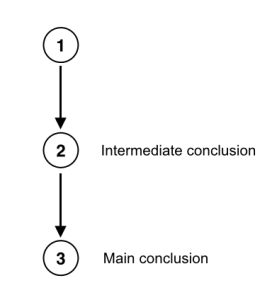
The main argument here (from 2 to 3) contains a subargument, in this case, the argument from 1 (a premise) to 2 (the intermediate conclusion). A subargument, as the term suggests, is a part of an argument that provides indirect support for the main argument. The main argument is simply the argument whose conclusion is the main conclusion.
Another type of structure that arguments can have is when two or more premises provide direct but independent support for the conclusion. Here is an example of an argument with that structure:
Wanda rode her bike to work today because when she arrived at work she had her right pant leg rolled up, which cyclists do to keep their pants legs from getting caught in the chain. Moreover, our co-worker, Bob, who works in accounting, saw her riding towards work at 7:45 a.m.
The conclusion of this argument is “Wanda rode her bike to work today”; two premises provide independent support for it: the fact that Wanda had her pant leg cuffed and the fact that Bob saw her riding her bike. Here is the argument in standard form:
- Wanda arrived at work with her right pant leg rolled up.
- Cyclists often roll up their right pant leg.
- Bob saw Wanda riding her bike towards work at 7:45.
- Therefore, Wanda rode her bike to work today. (from 1-2, 3 independently)
Again, notice that next to statement 4 of the argument is an indicator of how each part of the argument relates to the main conclusion. In this case, to avoid any ambiguity, you can see that the support for the conclusion comes independently from statements 1 and 2, on the one hand, and from statement 3, on the other hand. It is important to point out that an argument or subargument can be supported by one or more premises, the case in this argument because the main conclusion (4) is supported jointly by 1 and 2, and singly by 3. As before, we can represent the structure of this argument spatially, as the figure below shows:
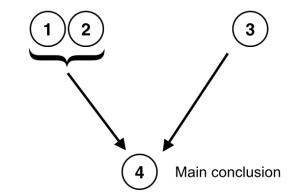
There are endless argument structures that can be generated from a few simple patterns. At this point, it is important to understand that arguments can have different structures and that some arguments will be more complex than others. Determining the structure of complex arguments is a skill that takes some time to master, rather like simplifying equations in math. Even so, it may help to remember that any argument structure ultimately traces back to some combination of premises, intermediate arguments, and a main conclusion.
Exercise 3 (OPTIONAL)
Write the following arguments in standard form. If any arguments are complex, show how each complex argument is structured using a diagram like those shown just above.
1. There is nothing wrong with prostitution because there is nothing wrong with consensual sexual and economic interactions between adults. Moreover, there is no difference between a man who goes on a blind date with a woman, buys her dinner and then has sex with her and a man who simply pays a woman for sex, which is another reason there is nothing wrong with prostitution.
2. Prostitution is wrong because it involves women who have typically been sexually abused as children. Proof that these women have been abused comes from multiple surveys done with female prostitutes that show a high percentage of self-reported sexual abuse as children.
3. Someone was in this cabin recently because warm water was in the tea kettle and wood was still smoldering in the fireplace. However, the person couldn’t have been Tim because Tim has been with me the whole time. Therefore, someone else must be in these woods.
4. Someone can be blind and yet run in the Olympic Games since Marla Runyan did it at the 2000 Sydney Olympics.
5. The train was late because it had to take a longer, alternate route seeing as the bridge was out.
6. Israel is not safe if Iran gets nuclear missiles because Iran has threatened multiple times to destroy Israel, and if Iran had nuclear missiles, it would be able to carry out this threat. Furthermore, since Iran has been developing enriched uranium, it has the key component needed for nuclear weapons; every other part of the process of building a nuclear weapon is simple compared to that. Therefore, Israel is not safe.
7. Since all professional hockey players are missing front teeth, and Martin is a professional hockey player, it follows that Martin is missing front teeth. Because almost all professional athletes who are missing their front teeth have false teeth, it follows that Martin probably has false teeth.
8. Anyone who eats the crab rangoon at China Food restaurant will probably have stomach troubles afterward. It has happened to me every time; thus, it will probably happen to other people as well. Since Bob ate the crab rangoon at China Food restaurant, he will probably have stomach troubles afterward.
9. Lucky and Caroline like to go for runs in the afternoon in Hyde Park. Because Lucky never runs alone, any time Albert is running, Caroline must also be running. Albert looks like he has just run (since he is panting hard), so it follows that Caroline must have run, too.
10. Just because Linda’s prints were on the gun that killed Terry and the gun was registered to Linda, it doesn’t mean that Linda killed Terry since Linda’s prints would certainly be on her own gun, and someone else could have stolen her gun and used it to kill Terry.
Key Takeaways: Components of Vocabulary and Argument
- Conclusion—a claim that is asserted as true. One part of an argument.
- Premise—a reason behind a conclusion. The other part of an argument. Most conclusions have more than one premise.
- Statement—a declarative sentence that can be evaluated as true or false. The parts of an argument, premises and the conclusion, should be statements.
- Standard Argument Form—a numbered breakdown of the parts of an argument (conclusion and all premises).
- Premise Indicators—terms that signal that a premise, or reason, is coming.
- Conclusion Indicator—terms that signal that a conclusion, or claim, is coming.
- Support—anything used as proof or reasoning for an argument. This includes evidence, experience, and logic.
- Warrant—the connection made between the support and the reasons of an argument.
- Counterargument—an opposing argument to the one you make. An argument can have multiple counterarguments.
- Complex Arguments–these are formed by more than individual premises that point to a conclusion. Complex arguments may have layers to them, including an intermediate argument that may act as both a conclusion (with its own premises) and a premise (for the main conclusion).
3. What Is Logic?
Logic, in its most basic sense, is the study of how ideas reasonably fit together. In other words, when you apply logic, you must be concerned with analyzing ideas and arguments by using reason and rational thinking, not emotions or mysticism or belief. As a dedicated field of study, logic belongs primarily to math, philosophy, and computer science; in these fields, one can get professional training in logic. However, all academic disciplines employ logic: to evaluate evidence, to analyze arguments, to explain ideas, and to connect evidence to arguments. One of the most important uses of logic is in composing and evaluating arguments.
The study of logic divides into two main categories: formal and informal. Formal logic is the formal study of logic. In other words, in math or philosophy or computer science, if you were to take a class on logic, you would likely be learning formal logic. The purpose of formal logic is to eliminate any imprecision or lack of objectivity in evaluating arguments. Logicians, scholars who study and apply logic, have devised a number of formal techniques that accomplish this goal for certain classes of arguments. These techniques can include truth tables, Venn diagrams, proofs, syllogisms, and formulae. The different branches of formal logic include, but are not limited to, propositional logic, categorical logic, and first order logic.
Informal logic is logic applied outside of formal study and is most often used in college, business, and life. According to The Stanford Encyclopedia of Philosophy,
For centuries, the study of logic has inspired the idea that its methods might be harnessed in efforts to understand and improve thinking, reasoning, and argument as they occur in real life contexts: in public discussion and debate; in education and intellectual exchange; in interpersonal relations; and in law, medicine, and other professions. Informal logic is the attempt to build a logic suited to this purpose. It combines the study of argument, evidence, proof and justification with an instrumental outlook which emphasizes its usefulness in the analysis of real life arguing.
When people apply the principles of logic to employ and evaluate arguments in real life situations and studies, they are using informal logic.
Why Is Logic Important?
Logic is one of the most respected elements of scholarly and professional thinking and writing. Consider that logic teaches us how to recognize good and bad arguments—not just arguments about logic, any argument. Nearly every undertaking in life will ultimately require that you evaluate an argument, perhaps several. You are confronted with a question: “Should I buy this car or that car?” “Should I go to this college or that college?” “Did that scientific experiment show what the scientist claims it did?” “Should I vote for the candidate who promises to lower taxes, or for the one who says she might raise them?” Your life is a long parade of choices.
When answering such questions, to make the best choices, you often have only one tool: an argument. You listen to the reasons for and against various options and must choose among them. Thus, the ability to evaluate arguments is an ability useful in everything that you will do—in your work, your personal life, and your deepest reflections. This is the job of logic.
If you are a student, note that nearly every discipline–be it a science, one of the humanities, or a study like business–relies upon arguments. Evaluating arguments is the most fundamental skill common to math, physics, psychology, history, literary studies, and any other intellectual endeavor. Logic alone tells you how to evaluate the arguments of any discipline.
The alternative to developing logic skills is to be always at the mercy of bad reasoning and, as a result, bad choices. Worse, you can be manipulated by deceivers. Speaking in Canandaigua, New York, on August 3, 1857, the escaped slave and abolitionist leader Frederick Douglass observed,
Power concedes nothing without a demand. It never did and it never will. Find out just what any people will quietly submit to and you have found out the exact measure of injustice and wrong which will be imposed upon them, and these will continue till they are resisted with either words or blows, or with both. The limits of tyrants are prescribed by the endurance of those whom they oppress.
Add this to Frederick Douglass’s words: If you find out just how much a person can be deceived, that is just how far she will be deceived. The limits of tyrants are also prescribed by the reasoning abilities of those they aim to oppress. What logic teaches you is how to demand and recognize good reasoning, and, hence, avoid deceit. You are only as free as your powers of reasoning enable.
The remaining part of this logic section will concern two types of logical arguments—inductive and deductive—and the tests of those arguments, including validity, soundness, reliability, and strength, so that you can check your own arguments and evaluate the arguments of others, no matter if those arguments come from the various academic disciplines, politics, the business world, or just discussions with friends and family.
What Is Deductive Argument?
A deductive argument is an argument whose conclusion is supposed to follow from its premises with absolute certainty, thus leaving no possibility that the conclusion doesn’t follow from the premises. If a deductive argument fails to guarantee the truth of the conclusion, then the deductive argument can no longer be called a deductive argument.
The Tests of Deductive Arguments: Validity and Soundness
So far in this chapter, you have learned what arguments are and how to determine their structure, including how to reconstruct arguments in standard form. But what makes an argument good or bad? There are four main ways to test arguments, two of which are for deductive arguments. The first test for deductive arguments is validity, a concept that is central to logical thinking. Validity relates to how well the premises support the conclusion and is the golden standard that every deductive argument should aim for. A valid argument is an argument whose conclusion cannot possibly be false, assuming that the premises are true. Another way to put this is as a conditional statement: A valid argument is an argument in which if the premises are true, the conclusion must be true. Here is an example of a valid argument:
- Violet is a dog.
- Therefore, Violet is a mammal. (from 1)
You might wonder whether it is true that Violet is a dog (maybe she’s a lizard or a buffalo—you have no way of knowing from the information given). But, for the purposes of validity, it doesn’t matter whether premise 1 is actually true or false. All that matters for validity is whether the conclusion follows from the premise. You can see that the conclusion—that Violet is a mammal—does seem to follow from the premise—that Violet is a dog. That is, given the truth of the premise, the conclusion has to be true. This argument is clearly valid because if you assume that “Violet is a dog” is true, then, since all dogs are mammals, it follows that “Violet is a mammal” must also be true. Thus, whether an argument is valid has nothing to do with whether the premises of the argument are actually true. Here is an example where the premises are clearly false, yet the argument is valid:
- Everyone born in France can speak French.
- Barack Obama was born in France.
- Therefore, Barack Obama can speak French. (from 1-2)
This is a valid argument. Why? Because when you assume the truth of the premises (everyone born in France can speak French, and Barack Obama was born in France) the conclusion (Barack Obama can speak French) must be true. Notice that this is so even though none of these statements is actually true. Not everyone born in France can speak French (think about people who were born there but then moved somewhere else where they didn’t speak French and never learned it), and Barack Obama was not born in France, but it is also false that Obama can speak French. However, the argument is still valid even though neither the premises nor the conclusion is actually true. That may sound strange, but if you understand the concept of validity, it is not strange at all. Remember: validity describes the relationship between the premises and conclusion, and it means that the premises imply the conclusion, whether or not that conclusion is true.
To better understand the concept of validity, examine this example of an invalid argument:
- George was President of the United States.
- Therefore, George was elected President of the United States. (from 1)
This argument is invalid because it is possible for the premise to be true and yet the conclusion false. Here is a counterexample to the argument. Gerald Ford was President of the United States, but he was never elected president because Ford replaced Richard Nixon when Nixon resigned in the wake of the Watergate scandal. Therefore, it does not follow that just because someone is President of the United States that he was elected President of the United States. In other words, it is possible for the premise of the argument to be true and yet the conclusion false. This means that the argument is invalid. If an argument is invalid, it will always be possible to construct a counterexample to show that it is invalid (as demonstrated in the Gerald Ford scenario). A counterexample is simply a description of a scenario in which the premises of the argument are all true while the conclusion of the argument is false.
Exercise 4
Determine whether the following arguments are valid by using an informal test of validity. (You can copy and paste the text into your document.) In other words, ask whether you can imagine a scenario in which the premises are both true and yet the conclusion is false. For each argument do the following: (1) If the argument is valid, explain your reasoning, and (2) if the argument is invalid, provide a counterexample. Remember, this is a test of validity, so you may assume all premises are true (even if you know or suspect they are not in real life) for the purposes of this assignment.
1. Katie is a human being. Therefore, Katie is smarter than a chimpanzee.
2. Bob is a fireman. Therefore, Bob has put out fires.
3. Gerald is a mathematics professor. Therefore, Gerald knows how to teach mathematics.
4. Monica is a French teacher. Therefore, Monica knows how to teach French.
5. Bob is taller than Susan. Susan is taller than Frankie. Therefore, Bob is taller than Frankie.
6. Craig loves Linda. Linda loves Monique. Therefore, Craig loves Monique.
7. Orel Hershizer is a Christian. Therefore, Orel Hershizer communicates with God.
8. All Muslims pray to Allah. Muhammad is a Muslim. Therefore, Muhammad prays to Allah.
9. Some protozoa are predators. No protozoa are animals. Therefore, some predators are not animals.
10. Charlie only barks when he hears a burglar outside. Charlie is barking. Therefore, there must be a burglar outside.
A good deductive argument is not only valid but also sound. A sound argument is a valid argument that has all true premises. That means that the conclusion, or claim, of a sound argument will always be true because if an argument is valid, the premises transmit truth to the conclusion on the assumption of the truth of the premises. If the premises are actually true, as they are in a sound argument, and since all sound arguments are valid, we know that the conclusion of a sound argument is true. The relationship between soundness and validity is easy to specify: all sound arguments are valid arguments, but not all valid arguments are sound arguments.
Professors will expect sound arguments in college writing. Philosophy professors, for the sake of pursuing arguments based on logic alone, may allow students to pursue unsound arguments, but nearly all other professors will want sound arguments. How do you make sure that all the premises of your argument are true? How can we know that Violet is a dog or that littering is harmful to animals and people? Answers to these questions come from evidence, often in the form of research.
Tip
One way to counter another’s argument is to question his premises and test them for soundness. If you find that one or more premise is unsound, you can add that information–and your explanations–to the support of your own argument.
One way to test the accuracy of a premise is to apply the following questions:
- Is there a sufficient amount of data?
- What is the quality of the data?
- Has additional data been missed?
- Is the data relevant?
- Are there additional possible explanations?
Determine whether the starting claim is based upon a sample that is both representative and sufficiently large, and ask yourself whether all relevant factors have been taken into account in the analysis of data that leads to a generalization.
Another way to evaluate a premise is to determine whether its source is credible. Ask yourself,
- Are the authors identified?
- What are their backgrounds?
- Was the claim something you found on an undocumented website?
- Did you find it in a popular publication or a scholarly one?
- How complete, how recent, and how relevant are the studies or statistics discussed in the source?
What Is Inductive Argument?
In contrast to a deductive argument, an inductive argument is an argument whose conclusion is supposed to follow from its premises with a high level of probability, which means that although it is possible that the conclusion doesn’t follow from its premises, it is unlikely that this is the case. Here is an example of an inductive argument:
Tweets is a healthy, normally functioning bird and since most healthy, normally functioning birds fly, Tweets most likely flies.
Notice that the conclusion, “Tweets probably flies,” contains the words “most likely.” This is a clear indicator that the argument is supposed to be inductive, not deductive. Here is the argument in standard form:
- Tweets is a healthy, normally functioning bird. (premise)
- Most healthy, normally functioning birds fly. (premise)
- Therefore, Tweets probably flies. (conclusion)
Given the information provided by the premises, the conclusion does seem to be well supported. That is, the premises provide strong reasons for accepting the conclusion. The inductive argument’s conclusion is a strong one, even though we can imagine a scenario in which the premises are true and yet the conclusion is false.
Remember, inductive arguments cannot guarantee the truth of the conclusion, which means they will look like invalid deductive arguments. Indeed, they are. There will be counterexamples for inductive arguments because an inductive argument never promises absolute truth. We measure inductive arguments by degrees of probability and plausibility, not absolute categories like validity and soundness. Validity and soundness do not allow for a sliding scale of degrees. They are absolute conditions: There is no such thing as being partially valid or somewhat sound.
Do not let this difference between deductive and inductive arguments cause you to privilege deductive and revile inductive because inductive arguments cannot guarantee truth. That is an unfair measure, and it is not practical. The truth is that most arguments we create and evaluate in life are inductive arguments. It might be helpful to think of deductive arguments as those created in perfect lab conditions, where all the ideal parameters can be met. Life is much messier than that, and we rarely get ideal conditions. One main reason is that we rarely ever have all the information we need to form an absolutely true conclusion. When new information is discovered, a scientist or historian or psychologist or business executive or a college student should investigate how it affects previous ideas and arguments, knowing that those previous ideas may need to be adjusted based on new information. For example, suppose that we added the following premise to our earlier argument:
Tweets is 6 feet tall and can run 30 mph. (premise)
When we add this premise, the conclusion that Tweets can fly would no longer be likely because any bird that is 6 feet tall and can run 30 mph, is not a kind of bird that can fly. That information leads us to believe that Tweets is an ostrich or emu, which are not kinds of birds that can fly.
The Tests of Inductive Arguments: Reliability and Strength
Inductive arguments can never lead to absolute certainty, which is one reason scholars keep studying and trying to add to knowledge. This does not mean, however, that any inductive argument will be a good one. Inductive arguments must still be evaluated and tested, and the two main tests are reliability and strength.
Test of reliability, much like that of validity for deductive arguments, tests an inductive argument’s reason, its internal logic. In other words, just because an inductive argument cannot guarantee a true conclusion doesn’t mean that it should not be logically constructed. One cannot make just any sort of claim, particularly one that does not have a reliable basis. Reliability, unlike validity, can be measured by degree. More reliable arguments are ones that have a more solid basis in reason. Consider this example:
Ninety-seven percent of BananaTM computers work without any glitches. (premise)
Max has a BananaTM computer. (premise)
Therefore, Max’s computer works without any glitches. (conclusion)
This argument has a high degree of reliability. While it may well be true that Max has one of the three percent of computers that have glitches, it is much more likely, given the initial premise that he does not. If the initial premise changes, however, so does the reliability of the argument:
Thirty-three percent of BananaTM computers work without any glitches.
Max has a BananaTM computer.
Therefore, Max’s computer works without any glitches.
Note how the degree of reliability has gone done dramatically. The argument can now be considered unreliable since the conclusion that Max’s computer will work without glitches is improbable given the premises provided. The conclusion still could be true, but it has tipped toward unlikely.
The second test of inductive arguments is strength. Strength, like reliability, can be measured by degree. Strong arguments must have the following conditions: (1) They must be reliable arguments; (2) they draw upon multiple lines of reasoning as support and/or a collection of data. Indeed, the more the data and the more the reasons for a conclusion, the stronger the argument. Consider the following argument:
Susie has walked by Mack the dog every day for ten days. (premise)
Mack the dog has never bitten Susie. (premise)
Thus, when Susie walks by Mack the dog today, he will not bite her. (conclusion)
This argument is reasonable; we can see that the premises may logically lead to the conclusion. However, the argument is not very strong as Susie has only walked by the dog for ten days. Is that enough data to make the conclusion a likely one? What if we had more data, like so—
Susie has walked by Mack the dog every day for five years.
Mack the dog has never bitten Susie.
Thus, when Susie walks by Mack the dog today, he will not bite her.
This argument, with more data to consider (five years of information instead of just ten days), is much stronger. An argument also gets stronger when reasons are added:
Susie has walked by Mack the dog every day for five years.
Mack the dog has never bitten Susie.
Mack’s owners trained him to be friendly to people. (additional premise)
Mack the dog’s breed is not known for aggression. (additional premise)
Thus, when Susie walks by Mack the dog today, he will not bite her.
This argument is even stronger. Not only does it have more data, but it also has additional reasons for Mack’s gentle nature.
Remember these tests when writing your own essays. You are most likely going to be using inductive arguments, and you should make them as reliable and strong as you can because you can bet your professors will be evaluating your arguments by those criteria as well.
What Are Logical Fallacies, and Why Should You Avoid Them?
Fallacies are errors or tricks of reasoning. A fallacy is an error of reasoning if it occurs accidentally; it is a trick of reasoning if a speaker or writer uses it to deceive or manipulate his audience. Fallacies can be either formal or informal.
Whether a fallacy is an error or a trick, whether it is formal or informal, its use undercuts the validity and soundness of any argument. At the same time, fallacious reasoning can damage the credibility of the speaker or writer and improperly manipulate the emotions of the audience or reader. This is a consideration you must keep in mind as a writer who is trying to maintain credibility (ethos) with the reader. Moreover, being able to recognize logical fallacies in the speech and writing of others can greatly benefit you as both a college student and a participant in civic life. Not only does this awareness increase your ability to think and read critically—and thus not be manipulated or fooled—but it also provides you with a strong basis for counter arguments.
Even more important, using faulty reasoning is unethical and irresponsible. Using logical fallacies can be incredibly tempting. The unfortunate fact is they work. Every day—particularly in politics and advertising—we can see how using faults and tricks of logic effectively persuade people to support certain individuals, groups, and ideas and, conversely, turn them away from others. Furthermore, logical fallacies are easy to use. Instead of doing the often difficult work of carefully supporting an argument with facts, logic, and researched evidence, the lazy debater turns routinely to the easy path of tricky reasoning. Human beings too often favor what is easy and effective, even if morally questionable, over what is ethical, particularly if difficult. However, your college professors’ task is not to teach you how to join the Dark Side. Their job is to teach you how to write, speak, and argue effectively and ethically. To do so, you must recognize and avoid the logical fallacies.
What Are Formal Fallacies?
Most formal fallacies are errors of logic: The conclusion does not really “follow from” (is not supported by) the premises. Either the premises are untrue, or the argument is invalid. Below is an example of an invalid deductive argument:
Premise: All black bears are omnivores.
Premise: All raccoons are omnivores.
Conclusion: All raccoons are black bears.
Bears are a subset of omnivores. Raccoons also are a subset of omnivores. But these two subsets do not overlap, and that fact makes the conclusion illogical. The argument is invalid—that is, the relationship between the two premises does not support the conclusion.
“Raccoons are black bears” is instantaneously recognizable as fallacious and may seem too silly to be worth bothering about. However, that and other forms of poor logic play out on a daily basis, and they have real world consequences. Below is an example of a common fallacious argument:
Premise: All Arabs are Muslims.
Premise: All Iranians are Muslims.
Conclusion: All Iranians are Arabs.
This argument fails on two levels. First, the premises are untrue because, although many Arabs and Iranians are Muslim, not all are. Second, the two ethnic groups (Iranians and Arabs) are sets that do not overlap; nevertheless, the two groups are confounded because they (largely) share one quality in common (being Muslim). One only has to look at comments on the web to realize that the confusion is widespread and that it influences attitudes and opinions about US foreign policy. The logical problems make this both an invalid and an unsound argument.
What Are Informal Fallacies?
Informal fallacies take many forms and are widespread in everyday discourse. Very often they involve bringing irrelevant information into an argument, or they are based on assumptions that, when examined, prove to be incorrect. Formal fallacies are created when the relationship between premises and conclusion does not hold up or when premises are unsound; informal fallacies are more dependent on misuse of language and of evidence.
It is easy to find lists of informal fallacies, but that does not mean that it is always easy to spot them.
How Can You Check for Logical Fallacies?
One way to go about evaluating an argument for fallacies is to return to the concept of the three fundamental appeals: ethos, logos, and pathos. As a quick reminder,
- Ethos is an appeal to ethics, authority, and/or credibility.
- Logos is an appeal to logic.
- Pathos is an appeal to emotion.
Once you have refreshed your memory of the basics, you may begin to understand how ethos, logos, and pathos can be used appropriately to strengthen your argument or inappropriately to manipulate an audience through the use of fallacies. Classifying fallacies as fallacies of ethos, logos, or pathos will help you to understand their nature and to recognize them. Please keep in mind, however, that some fallacies may fit into multiple categories. For more details and examples on errors in the rhetorical appeals, see Chapter 2, “Rhetorical Analysis.”
Fallacies of ethos relate to credibility. These fallacies may unfairly build up the credibility of the author (or his allies) or unfairly attack the credibility of the author’s opponent (or her allies). Some fallacies give an unfair advantage to the claims of the speaker or writer or an unfair disadvantage to his opponent’s claims. These are fallacies of logos. Fallacies of pathos rely excessively upon emotional appeals, attaching positive associations to the author’s argument and negative ones to his opponent’s position.
Key Takeaways: Logic
- Logic—shows how ideas fit together by using reason.
- Formal Logic—a formal and rigorous study of logic, such as in math and philosophy.
- Informal Logic—the application of logic to arguments of all types: in scholarship, in business, and in life. Informal logic is what this part of the chapter covers.
- Deductive Argument—guarantees a true conclusion based on the premises. The tests for deductive arguments are validity and soundness.
- Validity—a way to evaluate a deductive argument; a valid argument is one which, if the premises are true, the conclusion must be true.
- Soundness—the second way to evaluate a deductive argument; a sound argument is one where the argument is valid AND the premises have been shown to be true (via support).
- Inductive Argument—cannot guarantee a true conclusion but can only assert what is most likely to be true based on the premises and the support. The tests for inductive arguments are reliability and strength.
- Reliability—a test of reason for inductive arguments. Inductive arguments must still be reasonable, must still have a reliable basis in logic.
- Strength—another test for inductive arguments. Inductive arguments are stronger when they have more reasons and more data to support them.
- Logical Fallacy—a flaw or trick of logic to be avoided at all costs. Fallacies can be formal or informal. See the Repository of Logical Fallacies below for individual examples.
4. What Are the Different Types of Arguments in Writing?
Throughout this chapter, you have studied the definition of argument, parts of argument, and how to use logic in argument. This section brings all of the previous material together and tackles arguments in writing. Foremost on most students’ minds when taking college composition courses is this question: “How do I write an argument paper?” The answer is not a simple one because, as mentioned previously, arguments come in a variety of packages. This means that written arguments–whether in essay or some other form–also come in many different types.
Arguments of the Rhetorical Modes
Most arguments involve one or more of the rhetorical modes. Once again, rhetoric is the study and application of effective writing techniques. There are a number of standard rhetorical modes of writing—structural and analytical models that can be used effectively to suit different writing situations. The rhetorical modes include, but are not limited to, narrative, description, process analysis, illustration and exemplification, cause and effect, comparison, definition, persuasion, and classification. These modes will be covered in detail in Chapter 5, “Rhetorical Modes.” They are mentioned here, however, to make clear that any and all rhetorical modes can be used to pursue an argument. In fact, most professors will insist upon it.
Tip
Remember that when writing arguments, always be mindful of the point of view you should use. Most academic arguments should be pursued using third person. For more on this issue, see Chapter 4, “The Writing Process.”
Arguments of Persuasion
One of the most common forms of argument is that of persuasion, and often standardized tests, like the SOL, will provide writing prompts for persuasive arguments. On some level, all arguments have a persuasive element because the goal of the argument is to persuade the reader to take the writer’s claim seriously. Many arguments, however, exist primarily to introduce new research and interpretation whereas persuasive arguments expressly operate to change someone’s mind about an issue or a person.
A common type of persuasive essay is an Op-Ed article. Included in the opinion section of a newspaper, these articles are more appropriately called argument essays because most authors strive not only to make explicit claims but also to support their claims, sometimes even with researched evidence. These articles are often well-designed persuasive essays, written to convince readers of the writer’s way of thinking.
In addition to essays, other forms of persuasive writing exist. One common and important example is the job letter, where you must persuade others to believe in your merits as a worker and performer so that you might be hired.
In a persuasive essay, you should be sure to do the following:
- Clearly articulate your claim and the main reasons for it. Avoid forming a thesis based on a negative claim. For example, “The hourly minimum wage is not high enough for the average worker to live on.” This is probably a true statement, but persuasive arguments should make a positive case because a negative is hard to prove. That is, the thesis statement should focus on how the hourly minimum wage is too low or insufficient.
- Anticipate and address counterarguments. Think about your audience and the counterarguments they would mostly likely have. Acknowledging points of view different from your own also has the effect of fostering more credibility between you and the audience. They know from the outset that you are aware of opposing ideas and that you are not afraid to give them space.
- Make sure your support comes in many different forms. Use logical reasoning and the rhetorical appeals, but also strive for concrete examples from your own experience and from society.
- Keep your tone courteous, but avoid being obsequious. In other words, shamelessly appealing to your readers’ vanity will likely ring false. Aim for respectful honesty.
- Avoid the urge to win the argument. On some level, we all want to be right, and we want others to see the error of their ways. More times than not, however, arguments in which both sides try to win end up producing losers all around. The more productive approach is to persuade your audience to consider your claim as a sound one, not simply the right one.
Tip
Because argument writing is designed to convince readers of an idea they may not have known before or a side of an issue they may not agree with, you must think carefully about the attitude you wish to convey as you advance your argument. The overall attitude of a piece of writing is its tone, and it comes from the words you choose (for more on the importance of word choice, see Chapter 10, “Working with Words”) In argument writing, strive for the following:
- Confidence—The reader needs to know that you believe in what you say, so be confident. Avoid hedgy and apologetic language. However, be careful not to cross the line from confidence to overconfidence. Arrogance can rebuff your readers, even if they agree with you.
- Neutrality—While you may advocate for one side or way of thinking, you still must demonstrate that you are being as objective as you can in your analysis and assessment. Avoid loaded terms, buzzwords, and overly emotional language.
- Courtesy and fairness—Particularly when dealing with any counterarguments, you want your tone to reveal that you have given other points of view due consideration. Avoid being smug, snide, or harshly dismissive of other ideas.
Arguments of Evaluation
If you have ever answered a question about your personal take on a book or movie or television show or piece of music, you have given a review. Most times, these reviews are somewhat hasty and based on initial or shallow impressions. However, if you give thought to your review, if you explain more carefully what you liked or didn’t like and why, if you bring in specific examples to back up your points, then you have moved on to an argument of evaluation. Reviews of film, books, music, food, and other aspects of taste and culture represent the most familiar type of argument of evaluation. The main objective of an argument of evaluation is to render a critical judgment on the merits of something.
Another common argument of evaluation is the performance review. If you have ever held a job, you know what it feels like to be on the receiving end of such a review; your timeliness and productivity and attitude are scrutinized to determine if you have been a good worker or need to worry about looking for another job. If you are in any sort of supervisory position, you will be the one writing and delivering those reviews, and your own supervisor will want to know that you have logical justification and evidence for your judgements.
For all types of reviews or evaluation arguments, make sure to plan for the following:
- Declare your overall judgment of the subject under review—good, bad, or somewhere in between. This is your conclusion or thesis.
- Lay out the criteria for your judgment. In other words, your review must be based on logical criteria—i.e., the standards by which you evaluate something. For example, if you are reviewing a film, reasonable criteria would include acting, writing, storytelling, directing, cinematography, music, and special effects. If you are evaluating an employee, that criteria will change and more likely involve punctuality, aspects of job performance, and overall attitude on the job.
- Make sure to evaluate each criteria and provide evidence. Draw your evidence from what you are reviewing, and use as many specific examples as you can. In a movie review in which you think the acting quality was top notch, give examples of a particular style that worked well or lines delivered effectively or emotions realistically conveyed.
- Use concrete language. A review is only an argument if we can reasonably see—from examples and your explanations—how you arrived at your judgment. Vague or circular language (“I liked it because it was just really good!”) will keep your evaluation at the opinion level only, preventing it from being taken seriously as an argument.
- Keep the tone respectful—even if you ultimately did not like the subject of your review. Be as objective as you can when giving your reasons. Insulting language detracts from the seriousness of your analysis and makes your points look like personal attacks.

Roger Ebert (1942-2013), a movie reviewer for the Chicago Sun-Times, was once one of the most famous movie critics in America. His reviews provide excellent examples of the argument of evaluation.
Consider his review (https://tinyurl.com/y82ylaav)of the 2009 film Avatar and note how clearly he declares his judgements, how he makes his reader aware of just what standards he uses for judgement (his criteria), and how he uses a wealth of examples and reasons to back his critiques (although he is careful to avoid spoilers, the review went to print as the movie was coming out).
Sample Writing Assignment
Write a brief review (1 page) of your first job. How would you rate that experience, and what would your rating be based on?
- Declare your overall judgment of your job experience. This is your main claim.
- Come up with at least four criteria for evaluation. Give your judgment for each criteria. Include at least two specific examples to support each evaluation, and explain the logic of your support.
- Proofread for tone, making sure to look for any words that would cause a reader to think your critique was unfair or hostile. For example, even if you loathed your first job, treat it dispassionately, like you are a social scientist putting that work experience under a microscope. (This might allow you to say, for example, that although the job was dull and repetitive, it gave you some useful experience.)
Arguments of Fact and Explanation
In the beginning of this chapter, arguments were shown to be distinct from facts. Facts are not arguable, they do not have “two sides,” and they are not up for debate. However, as we well know, people disagree with facts all the time. We wouldn’t have a nonsense term like “alternative facts” otherwise. We do, however, have arguments that deal with this scenario: arguments of fact and explanation. Arguments of fact seek to establish, often in the face of doubters, that a fact is indeed true. Arguments of explanation establish why that fact is true. Not surprisingly, these arguments often go hand in hand, and they lie primarily in the domain of the research paper. For more detail on the research process, refer to Chapter 6, “Research”; this section will clarify these two types of argument.
Arguments of Fact: Many times, the goal of giving an argument is simply to establish that the conclusion is true. For example, to convince someone that obesity rates are rising in the US, the writer should cite evidence such as studies from the Center for Disease Control (CDC) and the National Institutes of Health (NIH). The studies cited would function as premises for the conclusion that obesity rates are rising:
Obesity is on the rise in the US because multiple studies carried out by the CDC and NIH have consistently shown a rise in obesity over the last four decades.
Putting this simple argument into standard form would look like this:
- Multiple studies by the CDC and NIH have consistently shown a rise in obesity over the last four decades. (premises)
- Therefore, obesity is on the rise in the US. (conclusion)
The standard form argument clearly distinguishes the premise from the conclusion and shows how the conclusion is supposed to be supported by the evidence offered in the premise. Again, the goal of this simple argument would be to convince someone that the conclusion is true. However, sometimes we already know that a statement or claim is true, and we are trying to establish why it is true rather than that it is true.
Arguments of Explanation: An argument that attempts to show why its conclusion is true is an explanation. Contrast the previous example with the following:
The reason that the rate of obesity is on the rise in the US is that the foods we most often consume over the past four decades have increasingly contained high levels of sugar and low levels of dietary fiber. Because eating foods high in sugar and low in fiber triggers the insulin system to start storing those calories as fat, it follows that people who consume foods high in sugar and low in fiber will tend to store more of the calories consumed as fat.
This passage gives an explanation for why obesity is on the rise in the US. Unlike the earlier example, here it is taken for granted that obesity is on the rise in the US. That is the claim whose truth the author must explain. The obesity explanation can also be put into standard form just like any other argument:
- Over the past four decades, Americans have increasingly consumed foods high in sugar and low in fiber. (premise)
- Consuming foods high in sugar and low in fat triggers the insulin system to start storing those calories as fat. (premise)
- When people store more calories as fat, they tend to become obese. (premise)
- Therefore, the rate of obesity is on the rise in the US. (conclusion)
Notice that in this explanation, the premises (1-3) attempt to explain why the conclusion is true, rather than a reason for thinking that the conclusion is true. That is, in an argument of explanation, we assume that what we are trying to explain (i.e., the conclusion) is true. In this case, the premises are supposed to show why we should expect or predict that the conclusion is true. Explanations often give us an understanding of why the conclusion is true.
Arguments of Interpretation
Arguments of interpretation come mainly in the form of critical analysis writing. Scholars and students use critical analysis to understand a text more deeply; therefore, it is common in disciplines in which texts are the main objects of study—literature, philosophy, and history. However, we can also think of critical analysis as any analysis where someone takes raw data—from texts, from objects and images, from laboratory experiments, from surveys of people—and analyzes that data to come up with what they mean. The “what it all means” is an interpretation. The argument in critical analysis writing is the interpretation of the data. This must be a logical interpretation with the data also used to support the interpretation through reasoning and examples.
The guidelines for analyzing data are determined by the experts in those areas. Scholars of the life, earth, and physical sciences; the social sciences; and the humanities gather all sorts of different data. When writing up an interpretation of that data, writers and researchers should follow the models and standards provided by experts in those fields of study. In college, professors are important sources of these models and standards.
In the humanities, particularly in literature, there are generally four ways (or perspectives) for analyzing a text: writing from the perspective of a reader, writing as if the text were an object of study, writing about or from the perspective of an author, and writing about where a text fits into a particular context.
- Writing from the perspective of a reader: You seek to understand a text through your own experience, yet you also try to understand how others who may be different from you understand the same writing through their experience. This is characterized by noting down first impressions and lines or words that strike you in profound ways. This sort of analysis is common in journal or response paper assignments and can be a simple way to begin a discussion of a text.
- Writing about the text as an object of study: This is a perspective that highlights what makes up that text and what meaning we can find in it. Finding meaning relies on identifying the patterns, segments, and strategies (devices) in the writing you choose to analyze. This is one of the most common types of essay assignments in a literature class.
- Writing about the text’s author: Sometimes this provides another perspective with which to deepen an understanding of a piece of writing. Examining his or her life, thought processes, behaviors, and beliefs can help you to further understand an author’s work. This type of analysis can be the basis of a research paper on a work of history or literature.
- Writing about the text’s context: This approach usually has to do with how a text compares to other texts as well as how the text interacts with history and society. When historians analyze texts, studying context is crucial, but contextual analysis can also be the focus of a literature essay.
The process of critical analysis is dependent on close reading of the data or text and is an analytical process in which the writer moves from analyzing the details of the text to a broader conclusion that is logically based on those details. What can confuse a lot of students is that formal essay structure is must be framed by the conclusion, not the details: They must establish the main claim immediately, and then use the reasons for the claim to organize the details in each body paragraph. For more on close reading, see Chapter 1, “Critical Reading.”
Figure 3.8 “From Analysis to Argument”
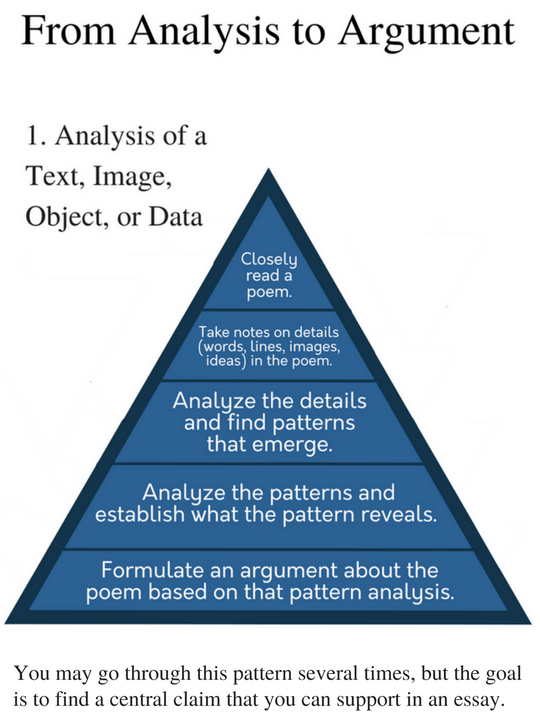
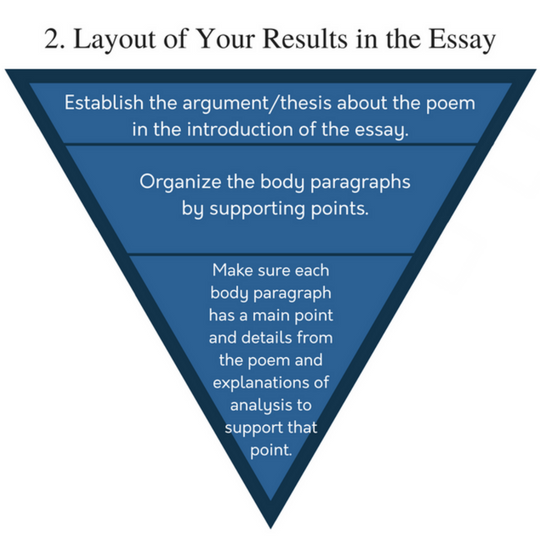
Rogerian Argument
The Rogerian argument, inspired by the influential psychologist Carl Rogers, aims to find compromise or common ground about an issue. If, as stated in the beginning of the chapter, academic or rhetorical argument is not merely a two-sided debate that seeks a winner and a loser, the Rogerian argument model provides a structured way to move beyond the win-lose mindset. Indeed, the Rogerian model can be employed to deal effectively with controversial arguments that have been reduced to two opposing points of view by forcing the writer to confront opposing ideas and then work towards a common understanding with those who might disagree.
Figure 3.9 “Carl Ransom Rogers”

The following are the basic parts of a Rogerian Argument:
1. Introduction: Introduce the issue under scrutiny in a non-confrontational way. Be sure to outline the main sides in the debate. Though there are always more than two sides to a debate, Rogerian arguments put two in stark opposition to one another. Crucially, be sure to indicate the overall purpose of the essay: to come to a compromise about the issue at hand. If this intent is not stated up front, the reader may be confused or even suspect manipulation on the part of the writer, i.e., that the writer is massaging the audience just to win a fight. Be advised that the Rogerian essay uses an inductive reasoning structure, so do not include your thesis in your introduction. You will build toward the thesis and then include it in your conclusion. Once again, state the intent to compromise, but do not yet state what the compromise is.
2. Side A: Carefully map out the main claim and reasoning for the opposing side of the argument first. The writer’s view should never really come first because that would defeat the purpose of what Rogers called empathetic listening, which guides the overall approach to this type of argument. By allowing the opposing argument to come first, you communicate to the reader that you are willing to respectfully consider another’s view on the issue. Furthermore, you invite the reader to then give you the same respect and consideration when presenting your own view. Finally, presenting the opposition first can help those readers who would side against you to ease into the essay, keeping them invested in the project. If you present your own ideas first, you risk polarizing those readers from the start, which would then make them less amenable to considering a compromise by the end of the essay. You can listen to Carl Rogers himself discuss the importance of empathy on YouTube (https://youtu.be/2dLsgpHw5x0, transcript here).
3. Side B: Carefully go over your side of the argument. When mapping out this side’s claim and support, be sure that it parallels that of Side A. In other words, make sure not to raise entirely new categories of support, or there can be no way to come to a compromise. Make sure to maintain a non-confrontational tone; for example, avoid appearing arrogant, sarcastic, or smug.
4. The Bridge: A solid Rogerian argument acknowledges the desires of each side and tries to accommodate both. In this part, point out the ways in which you agree or can find common ground between the two sides. There should be at least one point of agreement. This can be an acknowledgement of the one part of the opposition’s agreement that you also support or an admittance to a shared set of values even if the two sides come to different ideas when employing those values. This phase of the essay is crucial for two reasons: finding common ground (1) shows the audience the two views are not necessarily at complete odds, that they share more than they seem, and (2) sets up the compromise to come, making it easier to digest for all parties. Thus, this section builds a bridge from the two initial isolated and opposite views to a compromise that both sides can reasonably support.
5. The Compromise: Now is the time to finally announce your compromise, which is your thesis. The compromise is what the essay has been building towards all along, so explain it carefully and demonstrate the logic of it. For example, if debating about whether to use racial profiling, a compromise might be based on both sides’ desire for a safer society. That shared value can then lead to a new claim, one that disarms the original dispute or set of disputes. For the racial profiling example, perhaps a better solution would focus on more objective measures than race that would then promote safety in a less problematic way.
Figure 3.10 “Rogerian Argument”
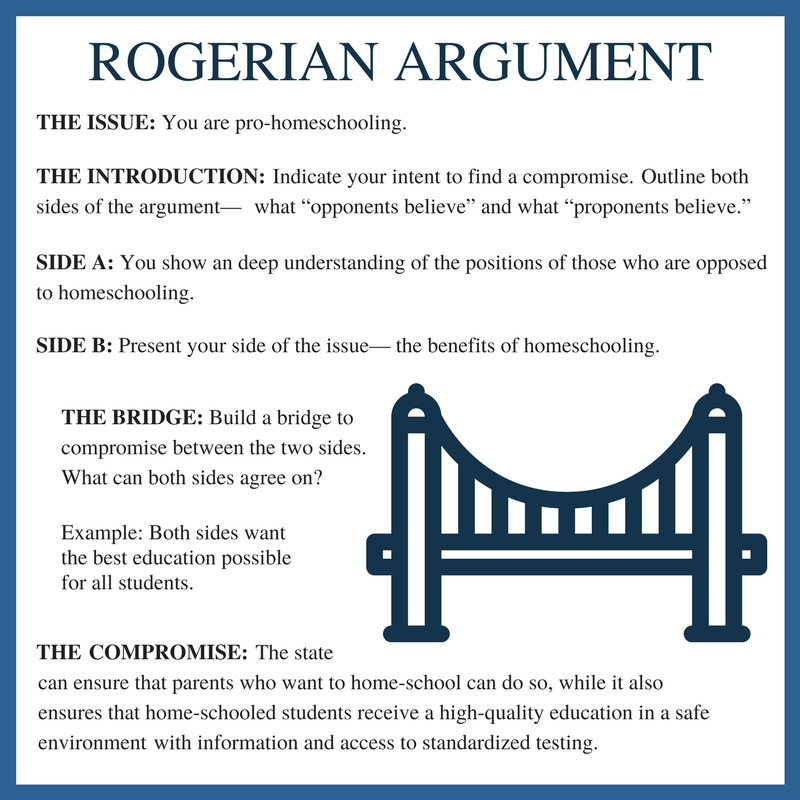
Key Takeaways: Types of Argument
- Arguments in the Rhetorical Modes—models of writing that can be used for an argument, including the rhetorical modes: narration, comparison, causal analysis, process, description, definition, classification, and exemplification.
- Arguments of Persuasion—used to change someone’s thinking on a topic or person.
- Arguments of Evaluation—critical reviews based on logical evaluation of criteria and evidence for that evaluation.
- Arguments of Fact and Explanation—establishes that a fact is true (the former) or why it is true (the latter).
- Arguments of Interpretation—critical analysis writing in which one makes an argument about what data mean. Data can come from texts, objects, surveys, and scientific experiments.
- The Rogerian Argument Model—an argument model designed to bring about consensus and mutual understanding rather than conflict.
- Toulmin’s Argument Model—six interrelated components used to diagram an argument, drawn from both rhetorical and academic argument.
5. A Repository of Logical Fallacies
Below is a list of informal fallacies, divided into four main categories: fallacies of irrelevance, presumption, ambiguity, and inconsistency. While this list is by no means exhaustive, it will include some of the most common fallacies used by writers and speakers, both in the world and in the classroom.
Fallacies of Irrelevance
One of the most common ways to go off track in an argument is to bring up irrelevant information or ideas. They are grouped here into two main categories: the red herring fallacies and the irrelevant appeals.
- Red Herring Fallacies—These aim to distract the reader by introducing irrelevant ideas or information. They divert attention away from the validity, soundness, and support of an argument. Think of red herrings as squirrels to a dog—almost impossible to resist chasing once spotted.
Figure 3.12 “Reagan’s Red Herring”

- Weak/False Analogy—An analogy is a brief comparison, usually to make writing more interesting and to connect with the reader. While writers often use analogies effectively to illustrate ideas, a bad analogy can be misleading and even inflammatory.
Example: “Taxes are like theft.” This statement makes a false analogy because taxes are legal and thus cannot logically be defined as, or even compared to, something illegal.
- Tu Quoque—Also known as an appeal to hypocrisy, this fallacy translates from the Latin as “you, too.” Known on grade school playgrounds around the world, this false argument distracts by turning around any critique on the one making the critique with the implication that the accuser should not have made the accusation in the first place because it reveals him as a hypocrite—even if the accusation or critique has validity.
Example 1: “Mom, Joey pushed me!” “Yeah, but Sally pushed me first!” Any sister who has ratted out a brother before knows she will have to deal with an immediate counter attack, claiming that she has perpetrated the same crime she has accused the brother of doing (and more than likely, she has done so). The brother hopes that the sister’s blatant hypocrisy will absolve him of his crime. Any veteran parent of siblings will know not to fall for this trick.
Example 2: Joe the Politician has been legitimately caught in a lie. Joe and his supporters try to deflect the damage by pointing out the times his opponents have been caught lying, too; this counter accusation implies that Joe’s lie should be excused because of the hypocrisy of those who found it and who dare to even talk about it. However, this counter accusation does not actually do anything logically to disprove or challenge the fact of Joe’s lie.
- Ad Hominem Attacks—The argumentum ad hominem is one of the most recognizable and irresistible of the red herring fallacies. Ad hominem attacks distract from an argument by focusing on the one making the argument, trying to damage his or her credibility. There are two main types of ad hominem attack: abuse and circumstance:
Ad hominem attacks of abuse are personal (often ruthlessly so), meant to insult and demean. Attacks of abuse distract the audience as well as the speaker or writer because he will believe it necessary to defend himself from the abuse rather than strengthen his argument.
Examples: These can include attacks on the body, intelligence, voice, dress, family, and personal choices and tastes.
Figure 3.13 “Student vs. Freud Ad Hominem”
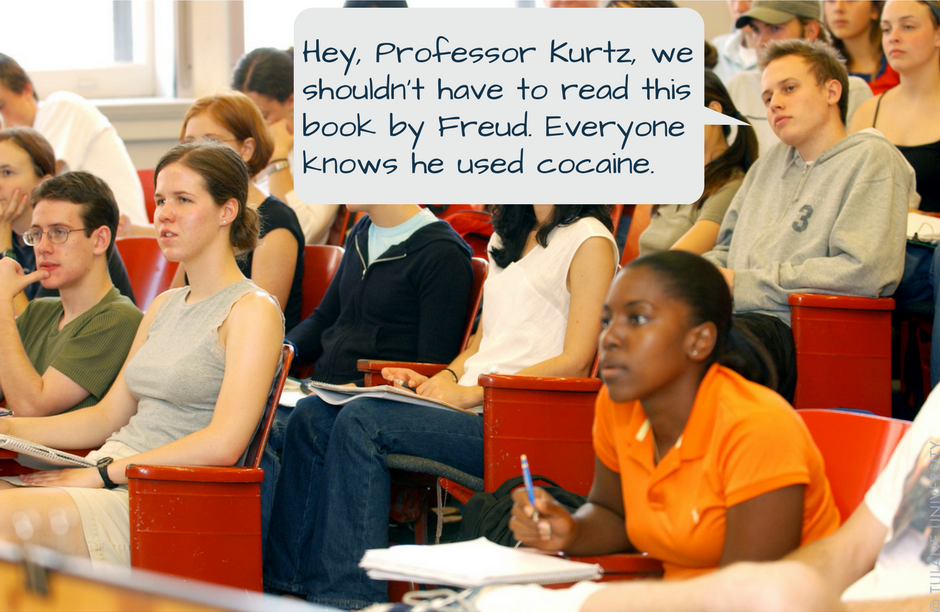
In ad hominem attacks of circumstance, the debater implies that his opponent only makes an argument because of a personal connection to it instead of the quality and support of the argument itself, which should be considered independent of any personal connection.
Example: “You only support the Latino for this job because you’re a Latino.”
This statement fails the logic test because it only takes a personal characteristic into account–race–when making this claim. This claim does not consider two important issues: (1) People do not base every decision they make on their race, and (2) there may have been other perfectly logical reasons to support the Latino job applicant that had nothing to do with race.
- Poisoning the Well—This is a type of ad hominem attack that attempts to damage the character of an opponent before that person even introduces an argument. Thus, by the time the argument is made, it often sounds weak and defensive, and the person making the argument may already be suspect in the minds of the audience.
Example: If a speaker calls out a woman for being overly emotional or hysterical, any heightened feeling—even a raised voice—may be attributed to her inability to control emotion. Furthermore, if that woman makes an argument, she can be ignored and her argument weakened because of the perception that it is rooted in emotion, not reason.
Figure 3.14 “Poisoning the Well”

- Guilt by Association—This red herring fallacy works by associating the author of an argument with a group or belief so abhorrent and inflammatory in the minds of the audience that everyone, author and audience alike, is chasing squirrels up trees—that is, they are occupied by the tainted association to the reviled group—instead of dealing with the merits of the original argument.
Example: the argumentum ad Nazium, or playing the Hitler card. To counter an argument, either the arguer or a part of the argument itself is associated with Hitler or the Nazis. (“Vegetarianism is a healthy option for dieters.” “Never! You know, Hitler was a vegetarian!”) Because almost no one wants to be associated with fascists (or other similarly hated groups, like cannibals or terrorists), the author now faces the task of defending himself against the negative association instead of pursuing the argument. If, however, there are actual Nazis–or the equivalent of Nazis, such as white supremacists or other neofascists–making an argument based on fascist ideology, it is perfectly reasonable to criticize, oppose, and object to their extreme and hateful views.
Figure 3.15 “Guilt by Association”

Irrelevant Appeals—Unlike the rhetorical appeals, the irrelevant appeals are attempts to persuade the reader with ideas and information that are irrelevant to the issues or arguments at hand, or the appeals rest on faulty assumptions in the first place. The irrelevant appeals can look and feel like logical support, but they are either a mirage or a manipulation.
- Appeal to Emotion—manipulates the audience by playing too much on emotion instead of rational support. Using scare tactics is one type of appeal to emotion. Using pity to pressure someone into agreement is another example.
Example: Imagine a prosecuting attorney in a murder case performing closing arguments, trying to convict the defendant by playing on the emotions of the jury: “Look at that bloody knife! Look at that poor, battered victim and the cruelty of all those terrible stab wounds!” The jury may well be swayed by such a blatant appeal to emotion–pity, horror, disgust—but this appeal doesn’t actually provide any concrete proof for the defendant’s guilt. If the lawyer has built a logical case that rests on an abundance of factual data, then this appeal to emotion may be justified as a way to personalize that data for the jury. If, however, the lawyer only uses this appeal to emotion, the argument for guilt is flawed because the lawyer has tried to make up for a weak case by turning the jury members’ emotions into the main evidence for guilt.
- Appeal to Popularity—Also known as the bandwagon fallacy, the appeal to popularity implies that because many people believe or support something, it constitutes evidence for its validity. However, once we stop to think this idea through, we can easily remember popular ideas that were not at all good or justifiable: The majority does not always make the best choice.
Example: A good example here would be fashion trends. What is popular from one day to the next does not necessarily have anything to do with whether something logically is a good idea or has practical use.
Figure 3.16 “Appeal to Popularity”

- Appeal to Incredulity—suggests that a lack of understanding is a valid excuse for rejecting an idea. Just because someone does not personally understand how something works does not mean that thing is false. A person does not need to understand how a car’s engine works to know that it does work, for instance. Often, in addition to rejecting the difficult idea, the arguer goes on to suggest that anyone who believes in the idea is foolish to do so.
Example: “It’s just common sense that the earth is flat because when I look at it, I can’t see any curve, not even when I’m in an airplane. I don’t need any scientist to tell me what I can clearly figure out with my own eyes.” This person has casually dismissed any scientific evidence against a flat earth as if it did not matter. Often those making an illogical appeal to incredulity will substitute what they think of as “common sense” for actual scientific evidence with the implication that they do not need any other basis for understanding. The problem is that many of the truths of our universe cannot be understood by common sense alone. Science provides the answers, often through complex mathematical and theoretical frameworks, but ignorance of the science is not a justifiable reason for dismissing it.
- Appeal to Nature—the assumption that what is natural is (1) inherently good and therefore (2) constitutes sufficient reason for its use or support. This is flawed because (1) how we determine what is natural can and does change, and (2) not everything that is natural is beneficial.
Example: “Vaccines are unnatural; thus, being vaccinated is more harmful than not being vaccinated.” A person making this statement has made an illogical appeal to nature. The fact that vaccines are a product of human engineering does not automatically mean they are harmful. If this person applied that logic to other cases, she would then have to reject, for instance, all medicines created in the lab rather than plucked from the earth.
- Appeal to Tradition/Antiquity—assumes that what is old or what “has always been done” is automatically good and beneficial. The objection, “But, we’ve always done it this way!” is fairly common, used when someone tries to justify or legitimize whatever “it” is by calling on tradition. The problems are these: (1) Most rudimentary history investigations usually prove that, in fact, “it” has not always been done that way; (2) tradition is not by itself a justification for the goodness or benefit of anything. Foot binding was a tradition at one point, but a logical argument for its benefit would strain credulity.
Example: “We should bar women from our club because that is how it has always been done.” The person making this argument needs to provide logical reasons women should not be included, not just rely on tradition.
- Appeal to Novelty—the mirror of the appeal to antiquity, suggesting that what is new is necessarily better.
Example: “Buy our new and improved product, and your life will forever be changed for the better!” Advertisers love employing the appeal to novelty to sell the public on the idea that because their product is new, it is better. Newness is no guarantee that something is good or of high quality.
- Appeal to Authority—Appealing to the ideas of someone who is a credentialed expert—or authority—on a subject can be a completely reasonable type of evidence. When one writes a research paper about chemistry, it is reasonable to use the works of credentialed chemists. However, the appeal to authority becomes a fallacy when misapplied. That same credentialed chemist would not be a logical authority to consult for information about medieval knights because authority in one area does not necessarily transfer to other areas. Another mistaken appeal to authority is to assume that because someone is powerful in some way that that power accords that person special knowledge or wisdom.
Example: Many societies throughout history have had hierarchical social and political structures, and those who happened to be in the top tier, like aristocrats and rulers, had authority over those below them. In fact, the term “nobility” in the west had embedded within it the notion that the aristocracy really were better—more ethical, more intelligent, more deserving of reward—than those lower on the social ladder. Careful study of the nobility shows, however, that some members were just as capable of immorality and stupidity as lower social groups.
- Appeal to Consequences/Force—the attempt to manipulate someone into agreement by either implicit or explicit threats of consequences or force (violence!).
Example: “Agree with me or you’ll be fired!” Holding something over another person’s head is not a reasonable way to support an argument. The arguer avoids giving any sort of logic or evidence in favor of a threat.
- Appeal to Wealth—the assumption that wealthy people have special knowledge or wisdom that derives from their economic position and that can then be applied to any area of knowledge.
Example: “Hi, I’m a famous actress, and while I’m not a qualified psychologist, read my new self-help book for how you, too, can avoid depression!” Fame and fortune alone do not turn someone into a qualified expert. Appealing to a person’s expertise solely based on wealth and position is thus logically flawed.
Figure 3.17 “Appeal to Wealth”

- Appeal to Poverty—the mirror of the above irrelevant appeal, that poor people have special knowledge or wisdom because of their adverse economic circumstances. This can work in another way: that poor people are particularly deficient in knowledge or wisdom because they are poor. However, neither assumption constitutes sound reasoning. The conditions of poverty are far too complex.
Example: “That man lives on unemployment benefits, so why would I care about his opinion on anything?” The arguer in this scenario unreasonably uses another’s poverty against him, by implying that a poor person would have worthless ideas. This implication has embedded within it the idea that someone is only poor because of some sort of personal lack–intelligence, morality, good sense, and so on. However, it is quite reasonable for a poor person to be intelligent, ethical, and wise. To assume otherwise is to risk making logical mistakes.
Fallacies of Presumption
To call someone presumptuous is to accuse that person of overreaching—making bold assertions without adequate reason or failing to follow the rules of behavior (but presuming it is okay to do so). The logical fallacy version of this involves making a case with inadequate or tainted evidence, or even no evidence whatsoever, or by having unjustified reasons for making the case in the first place.
Working with Flawed Evidence—These fallacies occur when an author uses evidence that has been compromised.
- Hasty Generalization—A hasty generalization derives its conclusion from too little information, evidence, or reason.
One type of hasty generalization is jumping to a conclusion from a small amount of evidence.
Example: Having one bad meal at a restaurant and then immediately concluding that all meals from that restaurant will be just as bad.
Figure 3.18 “Hasty Generalization”
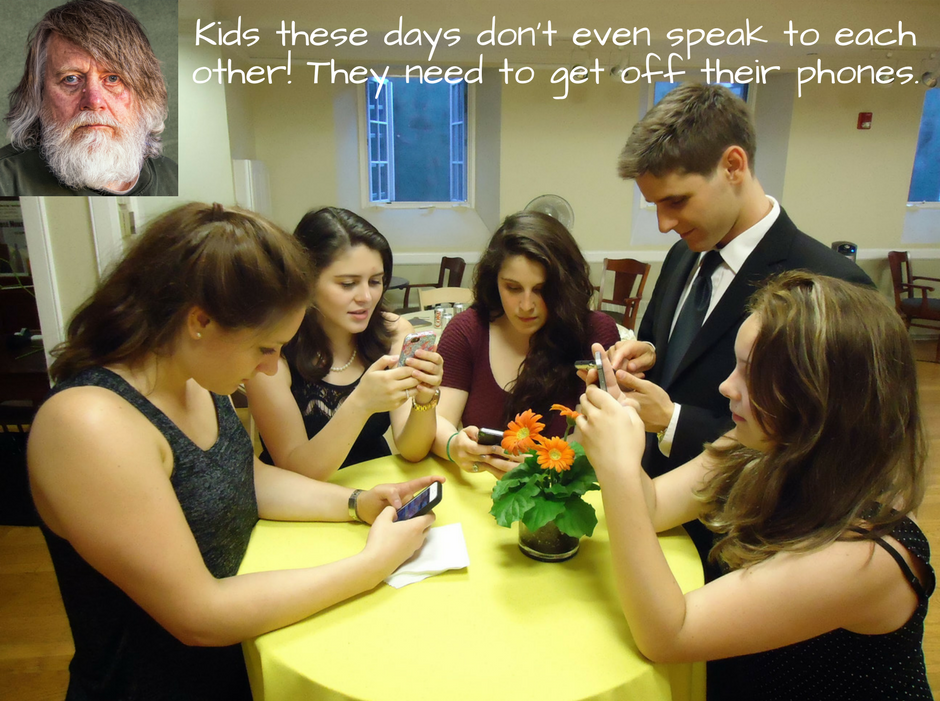
Another type of hasty generalization involves relying on anecdotal evidence for support. As human beings, we overestimate the power of personal experience and connections, so they can drown out scientific data that contradict an individual—or anecdotal—experience. Additionally, anecdotal evidence is persuasive because of the human desire for perfection. Perfection is a lofty—and mostly unreachable—goal, and when a product or a person or a program fails to live up to perfection, it becomes easier to dismiss—particularly when a personal story or two of imperfection is involved. Accurate information, however, comes from a much larger amount of data—analysis of hundreds or thousands or even millions of examples. Unfortunately, data can feel impersonal and, therefore, less convincing.
Example: “I love my new Bananatm laptop. The product ratings for it are very high.” “Oh, no one should ever buy one of their computers! My brother had one, and it was full of glitches.” Basing a judgement or an argument on a personal story or two, as in this case, is not logical but can be incredibly persuasive. However, if 98% of Bananatm computers run perfectly well, and only 2% have glitches, it is illogical to use that 2% to write this product off as universally terrible.
In scholarship, hasty generalizations can happen when conclusions derive from an unrepresentative sample. Data coming from a group that fail to represent the group’s full complexity is unrepresentative, and any results drawn from that data will be flawed.
Example: If advances in cancer research were only, or mostly, tested on men, that would be unrepresentative of humanity because half of the human population—women—would not be represented. What if the cancer treatments affect women differently?
Another type of hasty generalization derived from poor research is the biased sample. This comes from a group that has a predisposed bias to the concepts being studied.
Example: If a psychologist were to study how high school students handled challenges to their religious views, it would be flawed to only study students at schools with a religious affiliation since most of those students may be predisposed toward a single type of religious view.
- Sweeping Generalization—the inverse of the hasty generalization. Instead of making a conclusion from little evidence, the sweeping generalization applies a general rule to a specific situation without providing proper evidence, without demonstrating that the rule even applies, or without providing for exceptions. Stereotyping is one prominent type of sweeping generalization; a stereotype derives from general ideas about a group of people without accounting for exceptions or accuracy or that there is any sound reasoning behind the stereotype.
- Confirmation Bias—a pernicious fallacy that can trip even careful scholars. It occurs when the writer or researcher is so convinced by her point of view that she only seeks to confirm it and, thus, ignores any evidence that would challenge it. Choosing only data that support a preformed conclusion is called cherry picking and is a one-way ticket to skewed results. Related to this fallacy is another—disconfirmation bias—when the writer or researcher puts so much stock in her side of the argument that she does not apply equal critical evaluation to the arguments and evidence that support the other side. In other words, while too easily and uncritically accepting what supports her side, she is unreasonably critical of opposing arguments and evidence.
Example: In the later nineteenth century, when archaeology was a new and thrilling field of study, Heinrich Schliemann excavated the ancient city of Troy, made famous in Homer’s epic poem, The Iliad. In fact, Schliemann used The Iliad as a guide, so when he excavated, he looked to find structures (like walls) and situations (proof of battles) in the archaeological remains. While Schliemann’s work is still considered groundbreaking in many ways, his method was flawed. It allowed him to cherry pick his results and fit them to his expectations–i.e., that his results would fit the myth. When Schliemann sought to confirm story elements from The Iliad in the archaeological record, he risked misinterpreting his data. What if the data was telling a different story than that in The Iliad? How could he know for sure until he put the book down and analyzed the archaeological evidence on its own merits? For more on Schliemann and his famous early excavations, see his Encyclopedia Britannica entry (https://tinyurl.com/y9tk4vou), or look up “Heinrich Schliemann” in the Gale Virtual Reference Library database.
- No True Scotsman—a false claim to purity for something that is too complex for purity, like a group, an identity, or an organization. Those making claims to purity usually attempt to declare that anyone who does not fit their “pure” definition does not belong. For example, national identity is complicated and can mean something different to each person who claims that identity; therefore, it is too complex for a one-size-fits-all definition and for any one litmus test to prove that identity.
Examples: “No real Scot would put ice in his scotch!” “No real man would drink lite beer!” “No real feminist would vote Republican!” Each of these statements assumes that everyone has the same definition for the identities or groups discussed: Scots, men, and feminists. However, the members of each group are themselves diverse, so it is illogical to make such blanket declarations about them. It is actually quite reasonable for a Scottish person to like ice in her scotch and still claim a Scottish identity or for a man to drink lite beer without relinquishing his manhood or for a feminist to vote Republican while still working toward women’s rights.
Figure 3.19 “No True Southerner, No True Scotsman”

Working with No Evidence—These fallacies occur when the evidence asserted turns out to be no evidence whatsoever.
- Burden of Proof—This logical fallacy, quite similar to the appeal to ignorance, occurs when the author forgets that she is the one responsible for supporting her arguments and, instead, shifts the burden of proof to the audience.
Example: “Larry stole my painting,” Edith cried. “Prove to me he didn’t!” No: The one making the claim must give reasons and evidence for that claim before anyone else is obligated to refute it. If Edith cannot give sound proof of Larry’s guilt, the argument should be rejected.
- Arguing from Silence or Ignorance—Like the burden of proof fallacy, this one occurs when the author, either implicitly or explicitly, uses a lack of evidence as a type of proof. This is the basis for most conspiracy theory nonsense, as if the lack of evidence is so hard to believe, the only reason to explain why it is missing is a cover up. Remember, it is the writer’s job to present positive proof (evidence that actually exists and can be literally seen) to support any argument made. If a writer cannot find evidence, he must admit that he may be wrong and then, find a new argument!
Example: “There is no proof that Joe the Politician conspired with the Canadians to rig the elections.” “A-ha! That there is nothing to find is proof that he did! He must have paid off everyone involved to bury the evidence.” Lack of proof cannot be–in and of itself–a type of proof because it has no substance; it is a nothing. Is it possible that proof may arise in the future? Yes, but until it does, the argument that Joe and the Canadians rigged an election is illegitimate. Is it possible that Joe both rigged the election and paid people off to hide it? Again, yes, but there are two problems with this reasoning: (1) Possibility, like absence of evidence, is not in itself a type of evidence, and (2) possibility does not equal probability. Just because something is possible does not mean it is probable, let alone likely or a sure thing. Those supporting conspiracy theories try to convince others that lack of proof is a type of proof and that a remote possibility is actually a surety. Both fail the logic test.
Figure 3.20 “Arguing from Ignorance”
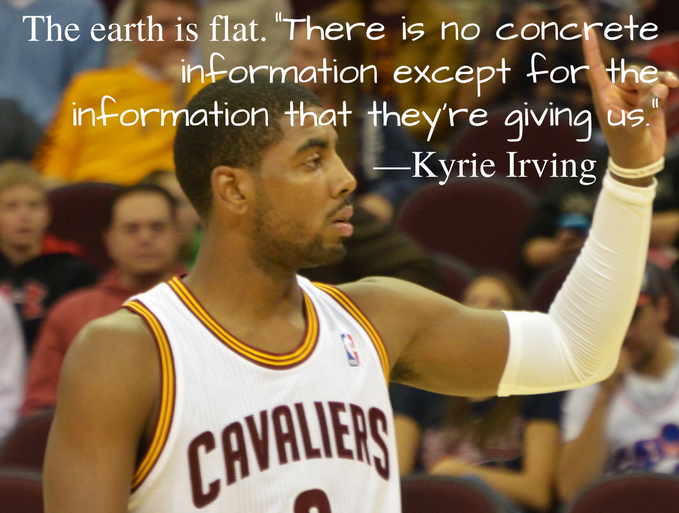
- Circular Reasoning—also known as begging the question, occurs when, instead of providing reasons for a claim, the arguer just restates the claim but in a different way. An author cannot sidestep reasons and proof for an argument by just repeating the claim over and over again.
Example: “The death penalty is sinful because it is wrong and immoral.” The conclusion (the death penalty is sinful) looks like it is supported by two premises (that it is wrong, that it is immoral). The problem is that the words “wrong” and “immoral” are too close in meaning to “sinful,” so they are not actual reasons; rather, they are just other ways to state the claim.
- Special Pleading—Anyone who makes a case based on special circumstances without actually providing any reasonable evidence for those circumstances is guilty of special pleading.
Example: “Is there any extra credit I can do to make up for my missing work?” Many students have asked this of their college professors. Embedded within the question is a logical fallacy, the insistence that the student asking it should get special treatment and be rewarded with extra credit even though he missed prior assignments. If the student has logical (and preferably documented) reasons for missing course work, then the fallacy of special pleading does not apply. Those expecting to be given special treatment without reasonable justification have committed the special pleading fallacy.
- Moving the Goalposts—happens when one keeps changing the rules of the game in mid-play without any reasonable justification.
Example: This fallacy occurs in Congress quite a lot, where the rules for a compromise are established in good faith, but one side or the other decides to change those rules at the last minute without good reason or evidence for doing so.
- Wishful Thinking—involves replacing actual evidence and reason with desire, i.e., desire for something to be true. Wanting an idea to be real or true, no matter how intensely, does not constitute rational support. This fallacy often occurs when closely-held ideas and beliefs are challenged, particularly if they are connected to family and identity or if they serve self interest.
Example: People do not like to see their personal heroes tarnished in any way. If a popular sports hero, e.g., is accused of a crime, many fans will refuse to believe it because they just don’t want to. This plays right into the wishful thinking fallacy.
Figure 3.21 “Wishful Thinking”

Working with False Ideas about Evidence or Reasoning—These fallacies either (1) presume something is a reason for or evidence of something else when that connection has not been adequately or fairly established or (2) unfairly limit one’s choices of possible reasons.
- False Dilemma/Dichotomy—occurs when one presents only two options in an argument when there are, in fact, many more options. Arguments have multiple sides, not just two, so when only two are presented, readers are forced to choose between them when they should be able to draw from a more complex range of options. Another way to talk about the false dichotomy is to call it reductionist because the arguer has reduced the options from many to only two.
Example: “So, are you a dog person or a cat person? Are you a Beatles person or a Rolling Stones person? You can be only one!” Both of these examples provide a false choice between two options when there are clearly others to choose from. One might also reasonably choose both or neither. When an arguer only provides two options, she tries to rig the response and to get the responder to only work within the severely limited framework provided. Life is more complicated than that, so it is unreasonable to limit choices to only two.
Figure 3.22 “False Dilemma”

- Loaded Question—embeds a hidden premise in the question, so anyone who responds is forced to accept that premise. This puts the responder at an unfair disadvantage because he has to either answer the question and, by doing so, accept the premise, or challenge the question, which can look like he is ducking the issue.
Example: “So, when did you start practicing witchcraft?” The hidden premise here is that the responder is a witch, and any reply is an admittance to that as a fact. An open question, one that does not trick the responder into admitting the presumption of witchcraft, would be this: “Are you a witch?”
False Cause—asserts causes that are more assumptions than actual causes. There are three types of false cause fallacies:
- Post hoc ergo propter hoc—In Latin, this phrase means “after this, therefore, because of this,” which asserts that when one thing happens before another thing, the first must have caused the second. This is a false assumption because, even if the two things are related to each other, they do not necessarily have a causal relationship.
Example: Superstitions draw power from this logical fallacy. If a black cat crosses Joe the Politician’s path, and the next day Joe loses the election, is he justified, logically, in blaming the cat? No. Just because the cat’s stroll happened before the election results does not mean the one caused the other.
Figure 3.23 “Post Hoc Ergo Propter Hoc”
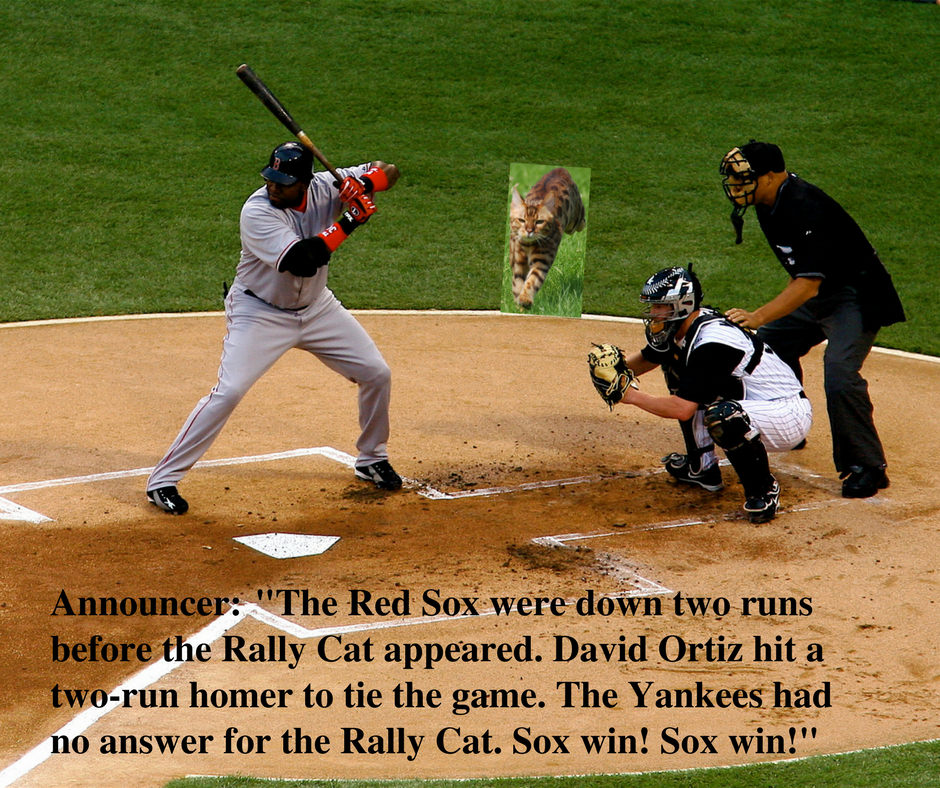
- Slippery Slope—the cause/effect version of jumping to a conclusion. A slippery slope argument claims that the first link in a causal chain will inevitably end in the most disastrous result possible, thus working to scare the audience away from the initial idea altogether. Keep in mind, legitimate and logical causal chains can be argued: where one cause leads to a logical effect, which then leads to the next logical effect, which then leads to the next logical effect, and so on. Those using the slippery slope fallacy, however, do not bother to carefully establish a logical chain but rather skip right ahead to the worst possible conclusion.
Example: “Oh no, if I fail this test, my whole life is ruined!” This is a common fear among panicked students but is a prime example of the slippery slope. The student likely imagines this sort of logical chain: a failed test → failed class → getting behind in college → flunking out of college → all future job prospects falling through → total unemployment → abject poverty → becoming a pariah to family and friends → a thoroughly ruined life. The worry is that failing a test, should it even happen at all, will automatically result in the worst possible case: a totally failed life. However, when thought through more calmly and logically, hopefully, the student will realize that many mitigating factors lie between one failed test and total ruination and that the total ruination result is actually quite unlikely.
- Cum hoc ergo propter hoc—In Latin, this phrase translates to “with this, therefore, because of this,” which suggests that because two or more things happen at the same time they must be related. This, however, doesn’t account for other logical possibilities, including coincidence.
Example: “Gah! Why does the phone always ring as we sit down to dinner?” This question implies that those two events have something to do with each other when there are likely far more logical reasons that they do not.
Fallacies of Ambiguity
To be ambiguous is to be unclear; thus, fallacies of ambiguity are those that, intentionally or not, confuse the reader through lack of clarity. They create a fog that makes it difficult to see what the conclusion or the reasonable parts of an argument are, or the fog prevents a reasonable conclusion in the first place.
- Quoting out of Context—occurs when quoting someone without providing all the necessary information to understand the author’s meaning. Lack of context means that the original quote’s meaning can be obscured or manipulated to mean something the original author never intended. Usually that context comes from the original text the quote came from that the borrower has failed to include or deliberately excluded.
Example: Original statement: “You may hand write your assignments but only when instructed to in the assignment schedule.”
Quote used: “You may hand write your assignments.”
Clearly, the quoted part leaves out some crucial information, qualifying information that puts limits on the initial instruction. The scenario may be this: The original statement came from a professor’s syllabus, and the student quoted just the first part to an advisor, for instance, while trying to register a complaint over a bad grade for an assignment he hand wrote but wasn’t supposed to. When the student exclaims, “But my professor told me I could hand write my assignments!” he is guilty of muddying the truth by quoting out of context. He left out the part that told him to verify the assignment instructions to see if handwriting were allowable or not.
- Straw Man—Creating a straw man argument involves taking a potentially reasonable argument and misrepresenting it, usually through scare tactics or oversimplification, i.e., by creating an argument that sounds similar to the original but in reality is not. The straw man argument is designed to be outrageous and upsetting, and thus easier to defeat or get others to reject. Why try to dismantle and rebut a reasonable argument when one can just knock the head off the straw man substitute instead?
Example: “I think we need to get rid of standardized testing in junior high and high school, at least in its current form.” “That’s terrible! I can’t believe you don’t want any standards for students. You just want education to get even worse!” In this scenario, the second person has committed the straw man fallacy. She has distorted the first person’s argument–that standardized testing in its current form should be eliminated–and replaced it with a much more objectionable one–that all educational standards should be eliminated. Because there are more ways than just testing to monitor educational standards, the second person’s argument is a blatant misrepresentation and an over simplification.
Figure 3.24 “Straw Man”

- Equivocation—happens when an author uses terms that are abstract or complex—and, therefore, have multiple meanings or many layers to them—in an overly simple or misleading fashion or without bothering to define the particular use of that term.
Example: “I believe in freedom.” The problem with this statement is it assumes that everyone understands just exactly what the speaker means by freedom. Freedom from what? Freedom to do what? Freedom in a legal sense? In an intellectual sense? In a spiritual sense? Using a vague sense of a complex concept like freedom leads to the equivocation fallacy.
Fallacies of Inconsistency
This category of fallacies involves a lack of logical consistency within the parts of the argument itself or on the part of the speaker.
- Inconsistency Fallacy—is one of the more blatant fallacies because the speaker is usually quite up-front about his inconsistency. This fallacy involves making contradictory claims but attempting to offset the contradiction by framing one part as a disclaimer and, thus, implying that the disclaimer inoculates the one making it from any challenge.
Example 1: “I’m not a racist but….” If what follows is a racist statement, the one saying this is guilty of the inconsistency fallacy and of making a racist statement. Making a bold claim against racism is not a shield.
Example 2: “I can’t be sexist because I’m a woman.” The speaker, when making this kind of statement and others like it, assumes that she cannot logically be called out for making a sexist statement because she happens to be a member of a group (women) who are frequent victims of sexism. If the statements she makes can objectively be called sexist, then she is guilty of both sexism and the inconsistency fallacy.
Figure 3.25 “Inconsistency Fallacy”

- False Equivalence—asserts that two ideas or groups or items or experiences are of equal type, standing, and quality when they are not.
Example: The belief in intelligent design and the theory of evolution are often falsely equated. The logical problem lies not with desire to support one or the other idea but with the idea that these two concepts are the same type of concept. They are not. Intelligent design comes out of belief, mainly religious belief, while evolution is a scientific theory underpinned by factual data. Thus, these two concepts should not be blithely equated. Furthermore, because these two concepts are not the same type, they do not need to be in opposition. In fact, there are those who may well believe in intelligent design while also subscribing to the theory of evolution. In other words, their religious beliefs do not restrict an adherence to evolutionary theory. A religious belief is faith based and, thus, is not evaluated using the same principles as a scientific theory would be.
- False Balance—applies mainly to journalists who, because they wish to present an appearance of fairness, falsely claim that two opposing arguments are roughly equal to each other when one actually has much more weight to it—of both reasoning and evidence.
Example: The majority of scientists accept climate change as established by empirical evidence, while a scant few do not; putting one representative of each on a news program, however, implies that they represent an equal number of people, which is clearly false.
Key Takeaways: Logical Fallacies
- Both formal and informal fallacies are errors of reasoning, and if writers rely on such fallacies, even unintentionally, they undercut their arguments, particularly their crucial appeals to logos. For example, if someone defines a key term in an argument in an ambiguous way or if someone fails to provide credible evidence, or if someone tries to distract with irrelevant or inflammatory ideas, her arguments will appear logically weak to a critical audience.
- More than just logos is at stake, however. When listeners or readers spot questionable reasoning or unfair attempts at audience manipulation, they may conclude that an author’s ethics have become compromised. The credibility of the author (ethos) and perhaps the readers’ ability to connect with that writer on the level of shared values (pathos) may well be damaged.
CC Licensed Content, Shared Previously
About Writing: A Guide, Robin Jeffrey, CC-BY.
A Concise Introduction to Logic, Craig DeLancey, CC-BY-NC-SA.
English 112: College Composition II, Lumen Learning, CC-BY-SA.
English Composition 1, Lumen Learning, CC-BY-SA.
Frameworks for Academic Writing, Stephen Poulter, CC-BY-NC-SA.
Introduction to Logic and Critical Thinking, Matthew J. Van Cleave, CC-BY.
Methods of Discovery, Pavel Zemilanski, CC-BY-NC-SA.
Writing for Success, CC-BY-NC-SA.
Writing in College: From Competence to Excellence, Amy Guptill, CC-BY-NC-SA.
Image Credits
Figure 3.1 “Opinion vs Argument,” by Kalyca Schultz, Virginia Western Community College, derivative image from original by ijmaki, pixabay, CC-0.
Figure 3.2 “Argument Diagram,” Virginia Western Community College, derivative image using “Thin Brace Down,” by pathoschild, Wikimedia, CC-BY-SA 3.0.
Figure 3.3 “Common Premise Indicators,” by Kalyca Schultz, Virginia Western Community College, CC-0.
Figure 3.4 “Common Conclusion Indicators,” by Kalyca Schultz, Virginia Western Community College, CC-0.
Figure 3.5 Untitled, by Matthew Van Cleave, from Introduction to Logic and Critical Thinking, CC-BY.
Figure 3.6 Untitled, by Matthew Van Cleave, from Introduction to Logic and Critical Thinking , CC-BY.
Figure 3.7 “Roger Ebert,” by Roger Ebert, Wikimedia, CC-BY-SA 3.0.
Figure 3.8 “From Analysis to Argument,” by Kalyca Schultz, Virginia Western Community College, CC-0.
Figure 3.9 “Carl Ransom Rogers,” by Didius, Wikimedia, CC-BY 2.5.
Figure 3.10 “Rogerian Argument,” by Kalyca Schultz, Virginia Western Community College, CC-0.
Figure 3.11 “Toulmin Argument,” Kalyca Schultz, Virginia Western Community College, CC-0.
Figure 3.12 “Reagan’s Red Herring,” by Dale Dulaney and Kalyca Schultz, Virginia Western Community College, CC-0, derivative image using “C25253-10.jpg,” by White House/Reagan Presidential Library, Wikimedia, CC-0.
Figure 3.13 “Student vs. Freud Ad Hominem,” by Dale Dulaney and Kalyca Schultz, Virginia Western Community College, CC-BY-2.0, derivative image using “Students in Class”, by Tulane University Public Relation, CC-BY-2.0.
Figure 3.14 “Poisoning the Well,” by Dale Dulaney and Kalyca Schultz, Virginia Western Community College, CC-0, derivative image from the original by jamesoladujoye , pixabay, CC-0.
Figure 3.15 “Guilt by Association,” by Dale Dulaney and Kalyca Schultz, Virginia Western Community College, CC-0, derivative image using “LettuceLadies-Guangzhou-092508,” by Ryan Huling, Wikimedia, CC-0.
Figure 3.16 “Appeal to Popularity,” by Dale Dulaney and Kalyca Schultz, Virginia Western Community College, CC-0, derivative image using the original by Max Pixel, CC-0.
Figure 3.17 “Appeal to Wealth,” by Dale Dulaney and Kalyca Schultz, Virginia Western Community College, CC-0, derivative image using the original by joharin.mymode, flickr, CC-0.
Figure 3.18 “Hasty Generalization,” by Dale Dulaney and Kalyca Schultz, Virginia Western Community College, CC-BY-2.0, derivative image using “Young People Texting on Smartphones Using Thumbs,” by Tomwsulcer, Wikimedia, CC-0, and “Old Guy,” by Randen Pederson, flickr, CC-BY 2.0.
Figure 3.19 “No True Southerner, No True Scotsman,” by Dale Dulaney and Kalyca Schultz, Virginia Western Community College, CC-BY-SA-2.0, derivative image using “Pimento Cheese” by Chip Harlan, Wikimedia, CC-BY-SA-2.0.
Figure 3.20 “Arguing from Ignorance,” by Dale Dulaney and Kalyca Schultz, Virginia Western Community College, CC-BY-2.0, derivative image using “Kyrie Irving“, by Erik Drost, Wikimedia, CC-BY 2.0.
Figure 3.21 “Wishful Thinking,” by Dale Dulaney and Kalyca Schultz, Virginia Western Community College, CC-0, derivative image using “Lance Armstrong – Tour de France 2003,” by Gawain78, Wikimedia, CC-0.
Figure 3.22 “False Dilemma”, by Dale Dulaney and Kalyca Schultz, Virginia Western Community College, CC-0, derivative image using “Bush State of the Union 2006,” by White House, CC-0, and “President Bush Delivers State of the Union Address,” by Sheelah Craighead, White House, CC-0.
Figure 3.23 “Rally Cat”, by Dale Dulaney and Kalyca Schultz, Virginia Western Community College., CC-BY-2.0, derivative image using “David Ortiz Batters Box,” by SecondPrintProductions, Wikimedia, CC-BY-2.0, and “Bengal Cat,” by Roberto Shabs, Wikimedia, CC-By-2.0.
Figure 3.24 “Gaming”, by Dale Dulaney and Kalyca Schultz, Virginia Western Community College, CC-BY-2.0, derivative image using “Dataspel,” by Magnus Froderberg, Wikimedia, CC-BY-2.0.
Figure 3.25 “Inconsistency Fallacy”, by Dale Dulaney and Kalyca Schultz, Virginia Western Community College, CC-0, derivative image using “Tea Party Where is the Cake Grandma,” by Assy , pixabay, CC-0.
